A Review of Microinjection Moulding of Polymeric Micro Devices
Abstract
:1. Introduction
2. Microinjection Moulding
2.1. Equipment Development
2.1.1. Single-Step System
2.1.2. Two-Step System
2.1.3. Three-Step System
2.2. Process-Rheology and Crystallisation and Morphology of Micro Products
2.2.1. Rheology of Polymer Material at Micro Scale
2.2.2. Crystallisation and Morphology Development
- (1)
- Crystallisation and crystal structures
- (2)
- Crystallisation kinetics under quiescent conditions
- (3)
- Flow-induced crystallisation
- (4)
- Morphology development and product properties in microinjection moulding
2.3. Tooling
2.4. Replication of High Aspect Ratio and Submicron Scale Features
3. Application Cases of Microinjection Moulded Polymeric Devices
3.1. Drug Delivery
3.2. Medical Implants
3.3. Microfluidic Devices
3.4. Functional Micro/Nano Structured Surfaces
3.5. Micro Optics
4. Conclusions and Challenges
Author Contributions
Funding
Acknowledgments
Conflicts of Interest
References
- Gülçür, M.; Romano, J.-M.; Penchev, P.; Gough, T.; Brown, E.; Dimov, S.; Whiteside, B. A cost-effective process chain for thermoplastic microneedle manufacture combining laser micro-machining and micro-injection moulding. CIRP J. Manuf. Sci. Technol. 2021, 32, 311–332. [Google Scholar] [CrossRef]
- Niculescu, A.-G.; Chircov, C.; Bîrcă, A.C.; Grumezescu, A.M. Fabrication and applications of microfluidic devices: A review. Int. J. Mol. Sci. 2021, 22, 2011. [Google Scholar] [CrossRef]
- Zhang, H.; Zhang, H.; Guan, T.; Wang, X.; Zhang, N. Prototyping and Production of Polymeric Microfluidic Chip. In Advances in Microfluidics and Nanofluids; IntechOpen: London, UK, 2021. [Google Scholar] [CrossRef]
- Gorazd, P.; Michael, V. The surface-to-volume ratio in thermal physics: From cheese cube physics to animal metabolism. Eur. J. Phys. 2008, 29, 369. [Google Scholar] [CrossRef]
- Zhang, N.; Chu, J.S.; Byrne, C.J.; Browne, D.J.; Gilchrist, M.D. Replication of micro/nano-scale features by micro injection molding with a bulk metallic glass mold insert. J. Micromech. Microeng. 2012, 22, 065019. [Google Scholar] [CrossRef]
- Nian, S.-C.; Wu, C.-Y.; Huang, M.-S. Warpage control of thin-walled injection molding using local mold temperatures. Int. Commun. Heat Mass Transf. 2015, 61, 102–110. [Google Scholar] [CrossRef]
- Masato, D.; Sorgato, M.; Lucchetta, G. Analysis of the influence of part thickness on the replication of micro-structured surfaces by injection molding. Mater. Des. 2016, 95, 219–224. [Google Scholar] [CrossRef]
- Available online: http://mydogisdeadli.blogspot.ie/2012/11/dry-glue-nanotechnology-today.html (accessed on 1 September 2022).
- Koska, A.K. Injection Molding of Polymeric Microfluidic Devices. Bilkent Universitesi (Turkey). 2013. Available online: https://www.proquest.com/dissertations-theses/injection-molding-polymeric-microfluidic-devices/docview/2665127446 (accessed on 1 September 2022).
- Su, Q.; Zhang, N.; Gilchrist, M.D. The use of variotherm systems for microinjection molding. J. Appl. Polym. Sci. 2016, 133, 42962. [Google Scholar] [CrossRef]
- Calaon, M.; Baruffi, F.; Fantoni, G.; Cirri, I.; Santochi, M.; Hansen, H.N.; Tosello, G. Functional analysis validation of micro and conventional injection molding machines performances based on process precision and accuracy for micro manufacturing. Micromachines 2020, 11, 1115. [Google Scholar] [CrossRef]
- Giboz, J.; Copponnex, T.; Mélé, P. Microinjection molding of thermoplastic polymers: A review. J. Micromech. Microeng. 2007, 17, R96. [Google Scholar] [CrossRef]
- Zhang, N.; Gilchrist, M.D. Characterization of microinjection molding process for milligram polymer microparts. Polym. Eng. Sci. 2014, 54, 1458–1470. [Google Scholar] [CrossRef]
- Zhao, B.; Qiang, Y.; Wu, W.; Jiang, B. Tuning Power Ultrasound for Enhanced Performance of Thermoplastic Micro-Injection Molding: Principles, Methods, and Performances. Polymers 2021, 13, 2877. [Google Scholar] [CrossRef]
- Battenfeld. Micro-Moulding: Battenfeld Injection Molding. Available online: http://www.battenfeld.ru/fileadmin/templates/docs/imm/microsystem_presentation.pdf (accessed on 1 September 2022).
- Arburg. Smaller Equals More Complex. Available online: http://www.cmmmagazine.com/moulding/smaller-equals-more-complex/ (accessed on 1 September 2022).
- Sancho, A.; Arribas, L.; Teixidor, D. Micro-Injection Moulding. In Micro-Manufacturing Technologies and Their Applications; Springer: Berlin/Heidelberg, Germany, 2017; pp. 23–66. [Google Scholar]
- Available online: https://www.interempresas.net/FeriaVirtual/Catalogos_y_documentos/7505/MicroPower_EN_2016-09.pdf (accessed on 1 September 2022).
- Yang, C. Flow-induced morphology evolution of uniformly miniaturized high-density polyethylene parts prepared by micro-injection molding. Int. J. Adv. Manuf. Technol. 2013, 68, 1745–1755. [Google Scholar] [CrossRef]
- Sorgato, M.; Masato, D.; Lucchetta, G. Effect of vacuum venting and mold wettability on the replication of micro-structured surfaces. Microsyst. Technol. 2017, 23, 2543–2552. [Google Scholar] [CrossRef]
- Lifton, V.A. Microfluidics: An enabling screening technology for enhanced oil recovery (EOR). Lab A Chip 2016, 16, 1777–1796. [Google Scholar] [CrossRef]
- Balcão, V.M.; Vila, M.M. Structural and functional stabilization of protein entities: State-of-the-art. Adv. Drug Deliv. Rev. 2015, 93, 25–41. [Google Scholar] [CrossRef]
- Aho, J.; Boetker, J.P.; Baldursdottir, S.; Rantanen, J. Rheology as a tool for evaluation of melt processability of innovative dosage forms. Int. J. Pharm. 2015, 494, 623–642. [Google Scholar] [CrossRef]
- Zhang, N.; Gilchrist, M. Characterization of thermo-rheological behavior of polymer melts during the micro injection moulding process. Polym. Test. 2012, 31, 748–758. [Google Scholar] [CrossRef]
- Fernandez, A.; Muniesa, M.; Javierre, C. In-line rheological testing of thermoplastics and a monitored device for an injection moulding machine: Application to raw and recycled polypropylene. Polym. Test. 2014, 33, 107–115. [Google Scholar] [CrossRef]
- Ramini, M.; Agnelli, S. Shear heating parameter of rubber compounds useful for process control in injection molding machine. Rubber Chem. Technol. 2020, 93, 729–737. [Google Scholar] [CrossRef]
- Dertinger, S.C.; Gallup, N.; Tanikella, N.G.; Grasso, M.; Vahid, S.; Foot, P.J.; Pearce, J.M. Technical pathways for distributed recycling of polymer composites for distributed manufacturing: Windshield wiper blades. Resour. Conserv. Recycl. 2020, 157, 104810. [Google Scholar] [CrossRef]
- Yao, D.; Kim, B. Simulation of the filling process in micro channels for polymeric materials. J. Micromech. Microeng. 2002, 12, 604–610. [Google Scholar] [CrossRef]
- Keller, A.; Machin, M.J. Oriented crystallization in polymers. J. Macromol. Sci. Part B 1967, 1, 41–91. [Google Scholar] [CrossRef]
- Blundell, D.J.; Keller, A.; Kovacs, A.J. A new self-nucleation phenomenon and its application to the growing of polymer crystals from solution. J. Polym. Sci. Part B Polym. Lett. 1966, 4, 481–486. [Google Scholar] [CrossRef]
- Hatzikiriakos, S.G. Wall slip of molten polymers. Prog. Polym. Sci. 2012, 37, 624–643. [Google Scholar] [CrossRef]
- Trotta, G.; Stampone, B.; Fassi, I.; Tricarico, L. Study of rheological behaviour of polymer melt in micro injection moulding with a miniaturized parallel plate rheometer. Polym. Test. 2021, 96, 107068. [Google Scholar] [CrossRef]
- Cai, B.; Jiang, J.; Cao, Y.; Sun, J.; Zhang, N.; Li, Q. Effect of Scale-Dependent Viscosity and Transesterification on Filling Behavior of Polycarbonate/Poly (ethylene terephthalate) Blends in Micro-Injection Molding. Macromol. Res. 2022, 30, 163–171. [Google Scholar] [CrossRef]
- Janeschitz-Krieg, H. Crystallization Modalities in Polymer Melt Processing: Fundamental Aspects of Structure Formation; Springer: Vienna, Australia, 2010. [Google Scholar] [CrossRef]
- Gilbert, M. States of aggregation in polymers. In Brydson’s Plastics Materials; Elsevier: Amsterdam, The Netherlands, 2017; pp. 39–57. [Google Scholar]
- Amin, D.; Wang, Z. Nonlinear rheology and dynamics of supramolecular polymer networks formed by associative telechelic chains under shear and extensional flows. J. Rheol. 2020, 64, 581–600. [Google Scholar] [CrossRef]
- Walter, A.V.; Jimenez, L.N.; Dinic, J.; Sharma, V.; Erk, K.A. Effect of salt valency and concentration on shear and extensional rheology of aqueous polyelectrolyte solutions for enhanced oil recovery. Rheol. Acta 2019, 58, 145–157. [Google Scholar] [CrossRef]
- Janeschitz-Kriegl, H. Crystallization Modalities in Polymer Melt Processing; Springer: Berlin/Heidelberg, Germany, 2018. [Google Scholar] [CrossRef]
- Mykhaylyk, O.O.; Chambon, P.; Impradice, C.; Fairclough, J.P.A.; Terrill, N.J.; Ryan, A.J. Control of structural morphology in shear-induced crystallization of polymers. Macromolecules 2010, 43, 2389–2405. [Google Scholar] [CrossRef]
- Fernandez-Ballester, L.; Thurman, D.W.; Zhou, W.; Kornfield, J.A. Effect of long chains on the threshold stresses for flow-induced crystallization in iPP: Shish kebabs vs sausages. Macromolecules 2012, 45, 6557–6570. [Google Scholar] [CrossRef]
- Mahmoud, Y.S. Material Microstructure and Phase Equilibria. Biomater. J. 2022, 1, 26–38. [Google Scholar] [CrossRef]
- Crist, B. Structure of polycrystalline aggregates. In Handbook of Polymer Crystallization; Wiley: Hoboken, NJ, USA, 2013; pp. 73–124. [Google Scholar]
- Uetani, K.; Hatori, K. Thermal conductivity analysis and applications of nanocellulose materials. Sci. Technol. Adv. Mater. 2017, 18, 877–892. [Google Scholar] [CrossRef]
- Lin, Y.; Bilotti, E.; Bastiaansen, C.W.; Peijs, T. Transparent semi-crystalline polymeric materials and their nanocomposites: A review. Polym. Eng. Sci. 2020, 60, 2351–2376. [Google Scholar] [CrossRef]
- Sun, N.; Yang, B.; Wang, L.; Feng, J.M.; Yin, B.; Zhang, K.; Yang, M.B. Crystallization behavior and molecular orientation of high density polyethylene parts prepared by gas-assisted injection molding. Polym. Int. 2012, 61, 622–630. [Google Scholar] [CrossRef]
- Tian, Y.; Zhu, C.; Gong, J.; Ma, J.; Xu, J. Transition from shish-kebab to fibrillar crystals during ultra-high hot stretching of ultra-high molecular weight polyethylene fibers: In situ small and wide angle X-ray scattering studies. Eur. Polym. J. 2015, 73, 127–136. [Google Scholar] [CrossRef]
- Clark, E.S. Structure development in injection molding acetal homopolymer. Appl. Polym. Symp. 1973, 20, 325–332. [Google Scholar]
- Tian, Y.; Zhu, C.; Gong, J.; Yang, S.; Ma, J.; Xu, J. Lamellae break induced formation of shish-kebab during hot stretching of ultra-high molecular weight polyethylene precursor fibers investigated by in situ small angle X-ray scattering. Polymer 2014, 55, 4299–4306. [Google Scholar] [CrossRef]
- Ameli, A.; Nofar, M.; Jahani, D.; Rizvi, G.; Park, C. Development of high void fraction polylactide composite foams using injection molding: Crystallization and foaming behaviors. Chem. Eng. J. 2015, 262, 78–87. [Google Scholar] [CrossRef]
- Iervolino, R. Rhelogy and Morphology of the Flow Induced Crystallization in Polymers; Universityà Degli Studi Di Salerno: Fisciano, Italy, 2006. [Google Scholar]
- Janeschitz-Kriegl, H.; Eder, G. Shear induced crystallization: A relaxation phenomenon in polymer melts: A re-collection. J. Macromol. Sci. Part B 2007, 46, 591–601. [Google Scholar] [CrossRef]
- Janeschitz-Kriegl, H.; Ratajski, E. Some fundamental aspects of the kinetics of flow-induced crystallization of polymers. Colloid Polymer Sci. 2010, 288, 1525–1537. [Google Scholar] [CrossRef]
- Avrami, M. Kinetics of phase change. I general theory. J. Chem. Phys. 1939, 7, 1103–1112. [Google Scholar] [CrossRef]
- Avrami, M. Kinetics of phase change. II transformation-time relations for random distribution of nuclei. J. Chem. Phys. 1940, 8, 212–224. [Google Scholar] [CrossRef]
- Osswald, T.A.; Menges, G. Materials Science of Polymers for Engineers; Hanser: Aachen, Germany, 2003. [Google Scholar]
- Wang, Z.; Ma, Z.; Li, L. Flow-induced crystallization of polymers: Molecular and thermodynamic considerations. Macromolecules 2016, 49, 1505–1517. [Google Scholar] [CrossRef]
- Bai, H.; Huang, C.; Xiu, H.; Zhang, Q.; Fu, Q. Enhancing mechanical performance of polylactide by tailoring crystal morphology and lamellae orientation with the aid of nucleating agent. Polymer 2014, 55, 6924–6934. [Google Scholar] [CrossRef]
- Janeschitz-Kriegl, H.; Ratajski, E.; Stadlbauer, M. Flow as an effective promotor of nucleation in polymer melts: A quantitative evaluation. Rheol Acta 2003, 42, 355–364. [Google Scholar] [CrossRef]
- Jerschow, P.; Janeschitz-Kriegl, H. On the development of oblong particles as precursors for polymer crystallization from shear flow: Origin of the so-called fine grained layers. Rheol Acta 1996, 35, 127–133. [Google Scholar] [CrossRef]
- Liedauer, S.; Eder, G.; Janeschitz-Kriegl, H.; Jerscjow, P.; Geymayer, W.; Ingolic, E. On the kinetics of shear induced crystallization in polypropylene. Int. Polym. Processing 1993, 3, 236–244. [Google Scholar] [CrossRef]
- Tiang, J.S. Shear Induced Crystallization of Nucleated Polymers; McGill University: Montreal, QC, Canada, 2010. [Google Scholar]
- Housmans, J.-W.; Steenbakkers, R.J.A.; Roozemond, P.C.; Peters, G.W.M.; Meijer, H.E.H. Saturation of pointlike nuclei and the transition to oriented structures in flow-induced crystallization of isotactic polypropylene. Macromolecules 2009, 42, 5728–5740. [Google Scholar] [CrossRef]
- Kumaraswamy, G. Crystallization of Polymers from Stressed Melts. J. Macromol. Sci. Part C 2005, 45, 375–397. [Google Scholar] [CrossRef]
- Mykhaylyk, O.O.; Chambon, P.; Graham, R.S.; Fairclough, J.P.A.; Olmsted, P.D.; Ryan, A.J. The specific work of flow as a criterion for orientation in polymer crystallization. Macromolecules 2008, 41, 1901–1904. [Google Scholar] [CrossRef]
- Kumaraswamy, G.; Verma, R.K.; Kornfield, J.A. Novel flow apparatus for investigating shear-enhanced crystallization and structure development in semicrystalline polymers. Rev. Sci. Instrum. 1999, 70, 2097–2104. [Google Scholar] [CrossRef]
- Feng, J.; Wang, L.; Zhang, R.-Y.; Wu, J.-J.; Wang, C.-Y.; Yang, M.-B.; Fu, X.-R. Formation of double skin-core orientated structure in injection-molded Polyethylene parts: Effects of ultra-high molecular weight Polyethylene and temperature field. J. Polym. Res. 2014, 21, 432. [Google Scholar] [CrossRef]
- Kumaraswamy, G.; Verma, R.K.; Issaian, A.M.; Wang, P.; Kornfield, J.A.; Yeh, F.; Hsiao, B.S.; Olley, R.H. Shear-enhanced crystallization in isotactic polypropylenePart 2. Analysis of the formation of the oriented “skin”. Polymer 2000, 41, 8931–8940. [Google Scholar] [CrossRef]
- Fernandez-Ballester, L.; Thurman, D.W.; Kornfield, J.A. Real-time depth sectioning: Isolating the effect of stress on structure development in pressure-driven flow. J. Rheol. 2009, 53, 1229–1254. [Google Scholar] [CrossRef]
- Zhao, Z.; Zhang, X.; Yang, Q.; Ai, T.; Jia, S.; Zhou, S. Crystallization and microstructure evolution of microinjection molded isotactic polypropylene with the assistance of poly (ethylene terephthalate). Polymers 2020, 12, 219. [Google Scholar] [CrossRef]
- Whiteside, B.R.; Martyn, M.T.; Coates, P.D.; Greenway, G.; Allen, P.; Hornsby, P. Micromoulding: Process measurements, product morphology and properties. Plast. Rubber Compos. 2004, 33, 11–17. [Google Scholar] [CrossRef]
- Liu, F.; Guo, C.; Wu, X.; Qian, X.; Liu, H.; Zhang, J. Morphological comparison of isotactic polypropylene parts prepared by micro-injection molding and conventional injection molding. Polym. Adv. Technol. 2012, 23, 686–694. [Google Scholar] [CrossRef]
- Chu, J.-S.; Kamal, M.R.; Derdouri, A.; Hrymak, A. Morphology development in the gate region of microinjection-molded thermoplastics. Polym. Eng. Sci. 2012, 52, 787–794. [Google Scholar] [CrossRef] [Green Version]
- Kamal, M.R.; Chu, J.-S.; Derdouri, S.; Hrymak, A. Morphology of microinjection moulded polyoxymethylene. Plast. Rubber Compos. 2010, 39, 332–341. [Google Scholar] [CrossRef]
- Giboz, J.; Spoelstra, A.B.; Portale, G.; Copponnex, T.; Meijer, H.E.H.; Peters, G.W.M.; Mélé, P. On the origin of the “core-free” morphology in microinjection-molded HDPE. J. Polym. Sci. Part B Polym. Phys. 2011, 49, 1470–1478. [Google Scholar] [CrossRef]
- Hiroshi, I.; Yagisawa, Y.; Takushi, S.; Toshiyuki, Y.; Takeshi, K. Structural development in thin-wall injection molding process. Theor. Appl. Mech. Jpn. 2005, 54, 263–268. [Google Scholar]
- Whiteside, B.R.; Martyn, M.T.; Coates, P.D.; Allan, P.S.; Hornsby, P.R.; Greenway, G. Micromoulding: Process characteristics and product properties. Plast. Rubber Compos. 2003, 32, 231–239. [Google Scholar] [CrossRef]
- Martyn, M.T.; Whiteside, B.; Coates, P.D.; Allan, P.S.; Hornsby, P. Studies of the process-property interaction of the micromoulding process. In Proceedings of the Annual Technical Conference (ANTEC 2001), Brookfield Center, CT, USA, 5–9 May 2001. [Google Scholar]
- Hiroshi, I.; Yusuke, Y.; Takushi, S.; Toshiyuki, Y.; Takeshi, K.; Yoshitoshi, Y. Fundamental study on structure development of thin-wall injection molded products. Theor. Appl. Mech. Jpn. 2005, 54, 263–268. [Google Scholar] [CrossRef]
- Hiroshi, I.; Hajime, S.; Kunihiko, K.; Takeshi, K. Polymer structure and properties in micro- and nanomolding process. Curr. Appl. Phys. 2009, 9, 19–24. [Google Scholar] [CrossRef]
- Tada, K.; Fukuzawa, D.; Watanabe, A.; Ito, H. Numerical simulation for flow behaviour on micro- and nanomoulding. Plast. Rubber Compos. 2010, 39, 321–326. [Google Scholar] [CrossRef]
- Haberstroh, E.; Brandt, M. Determination of mechanical properties of thermoplastics suitable for microsystems. Macromol. Mater. Eng. 2002, 287, 881–888. [Google Scholar] [CrossRef]
- Zhang, N.; Su, Q.; Choi, S.Y.; Gilchrist, M.D. Effects of gate design and cavity thickness on filling, morphology and mechanical properties of microinjection mouldings. Mater. Des. 2015, 83, 835–847. [Google Scholar] [CrossRef]
- Jungmeier, A.; Ehrenstein, G.W.; Drummer, D. New aspects of process induced properties of microinjection moulded parts. Plast. Rubber Compos. 2010, 39, 308–314. [Google Scholar] [CrossRef]
- Guo, C.; Liu, F.H.; Wu, X.; Liu, H.; Zhang, J. Morphological evolution of HDPE parts in the microinjection molding: Comparison with conventional injection molding. J. Appl. Polym. Sci. 2012, 126, 452–462. [Google Scholar] [CrossRef]
- Zhang, N.; Choi, S.Y.; Gilchrist, M.D. Flow induced crystallization of poly (ether-block-amide) from the microinjection molding process and its effect on mechanical properties. Macromol. Mater. Eng. 2014, 299, 1362–1383. [Google Scholar] [CrossRef]
- Zhang, H.; Zhang, N.; Gilchrist, M.; Fang, F. Advances in precision micro/nano-electroforming: A state-of-the-art review. J. Micromech. Microeng. 2020, 30, 103002. [Google Scholar] [CrossRef]
- Zhang, H.; Zhang, N.; Fang, F. Electrodeposition of Nickel/Graphene Oxide Particle Composite Coatings: Effect of Surfactants on Graphene Oxide Dispersion and Coating Performance. J. Electrochem. Soc. 2020, 167, 162501. [Google Scholar] [CrossRef]
- Zhang, H.; Zhang, N.; Fang, F. Synergistic effect of surfactant and saccharin on dispersion and crystal refinement for electrodeposition of nanocrystalline nickel/graphene oxide composite. Surf. Coat. Technol. 2020, 402, 126292. [Google Scholar] [CrossRef]
- Zhang, H.; Zhang, N.; Fang, F. Fabrication of high-performance nickel/graphene oxide composite coatings using ultrasonic-assisted electrodeposition. Ultrason. Sonochemistry 2020, 62, 104858. [Google Scholar] [CrossRef]
- Nguyen, T.; Chidambara Vinayaka, A.; Duong Bang, D.; Wolff, A. A complete protocol for rapid and low-cost fabrication of polymer microfluidic chips containing three-dimensional microstructures used in point-of-care devices. Micromachines 2019, 10, 624. [Google Scholar] [CrossRef]
- Nguyen, T.; Ngo, T.A.; Bang, D.D.; Wolff, A. Optimising the supercritical angle fluorescence structures in polymer microfluidic biochips for highly sensitive pathogen detection: A case study on Escherichia coli. Lab A Chip 2019, 19, 3825–3833. [Google Scholar] [CrossRef]
- Vinayaka, A.C.; Ngo, T.A.; Nguyen, T.; Bang, D.D.; Wolff, A. Pathogen concentration combined solid-phase PCR on supercritical angle fluorescence microlens array for multiplexed detection of invasive nontyphoidal Salmonella serovars. Anal. Chem. 2020, 92, 2706–2713. [Google Scholar] [CrossRef]
- Becker, H.; Beckert, E.; Gärtner, C. Hybrid tooling technologies for injection molded and hot embossed polymeric microfluidic devices. In Proceedings of the SPIE MOEMS-MEMS, 2010, San Francisco, CA, USA, 23–28 January 2010; p. 75930B. [Google Scholar] [CrossRef]
- Tan, N.Y.J.; Zhang, X.; Neo, D.W.K.; Huang, R.; Liu, K.; Kumar, A.S. A review of recent advances in fabrication of optical Fresnel lenses. J. Manuf. Processes 2021, 71, 113–133. [Google Scholar] [CrossRef]
- Tosello, G.; Bissacco, G.; Tang, P.T.; Hansen, H.N.; Nielsen, P.C. High aspect ratio micro tool manufacturing for polymer replication using μEDM of silicon, selective etching and electroforming. Microsyst. Technol. 2008, 14, 1757–1764. [Google Scholar] [CrossRef]
- Zhang, H.; Zhang, N.; Fang, F. Investigation of mass transfer inside micro structures and its effect on replication accuracy in precision micro electroforming. Int. J. Mach. Tools Manuf. 2021, 165, 103717. [Google Scholar] [CrossRef]
- Zhang, H.; Zhang, N.; Fang, F. Study on controllable thickness and flatness of wafer-scale nickel shim in precision electroforming process: Simulation and validation. J. Manuf. Sci. Eng. 2021, 143, 111005. [Google Scholar] [CrossRef]
- Zhang, H.; Zhang, N.; Fang, F. Study of ion transportation and electrodeposition under hybrid agitation for electroforming of variable aspect ratios micro structures. Precis. Eng. 2021, 72, 122–143. [Google Scholar] [CrossRef]
- Browne, D.; Stratton, D.; Gilchrist, M.; Byrne, C. Bulk metallic glass multiscale tooling for molding of polymers with micro to nano features: A review. Met. Mat. Trans. A 2012, 44, 2021–2030. [Google Scholar] [CrossRef]
- David, L.H.; Vikas, S.; Hayden, K.T.; Melinda, R.H.; David, E.H.; Lallit, A. Metallic glasses: Viable tool materials for the production of surface microstructures in amorphous polymers by micro-hot-embossing. J. Micromech. Microeng. 2009, 19, 115030. [Google Scholar] [CrossRef]
- Zhang, H.; Guan, T.; Zhang, N.; Fang, F. Fabrication of permanent self-lubricating 2D material-reinforced nickel mould tools using electroforming. Int. J. Mach. Tools Manuf. 2021, 170, 103802. [Google Scholar] [CrossRef]
- Gustafsson, O.; Mogensen, K.B.; Kutter, J.P. Underivatized cyclic olefin copolymer as substrate material and stationary phase for capillary and microchip electrochromatography. Electrophoresis 2008, 29, 3145–3152. [Google Scholar] [CrossRef]
- Yao, D.; Chen, S.-C.; Kim, B.H. Rapid thermal cycling of injection molds: An overview on technical approaches and applications. Adv. Polym. Technol. 2008, 27, 233–255. [Google Scholar] [CrossRef]
- Hou, J.; Zhang, H.; Zhang, N.; Fang, F. Characterization of manufacturability of microstructures for micro-injection moulding of micro devices using star patterns. J. Micromech. Microeng. 2019, 30, 025001. [Google Scholar] [CrossRef]
- Maghsoudi, K.; Jafari, R.; Momen, G.; Farzaneh, M. Micro-nanostructured polymer surfaces using injection molding: A review. Mater. Today Commun. 2017, 13, 126–143. [Google Scholar] [CrossRef]
- Duarah, S.; Sharma, M.; Wen, J. Recent advances in microneedle-based drug delivery: Special emphasis on its use in paediatric population. Eur. J. Pharm. Biopharm. 2019, 136, 48–69. [Google Scholar] [CrossRef]
- Ma, G.; Wu, C. Microneedle, bio-microneedle and bio-inspired microneedle: A review. J. Control. Release 2017, 251, 11–23. [Google Scholar] [CrossRef]
- Erdem, Ö.; Eş, I.; Akceoglu, G.A.; Saylan, Y.; Inci, F. Recent advances in microneedle-based sensors for sampling, diagnosis and monitoring of chronic diseases. Biosensors 2021, 11, 296. [Google Scholar] [CrossRef]
- Al-Japairai, K.A.S.; Mahmood, S.; Almurisi, S.H.; Venugopal, J.R.; Hilles, A.R.; Azmana, M.; Raman, S. Current trends in polymer microneedle for transdermal drug delivery. Int. J. Pharm. 2020, 587, 119673. [Google Scholar] [CrossRef]
- Ye, Y.; Yu, J.; Wen, D.; Kahkoska, A.R.; Gu, Z. Polymeric microneedles for transdermal protein delivery. Adv. Drug Deliv. Rev. 2018, 127, 106–118. [Google Scholar] [CrossRef]
- Sammoura, F.; Kang, J.; Heo, Y.-M.; Jung, T.; Lin, L. Polymeric microneedle fabrication using a microinjection molding technique. Microsyst. Technol. 2007, 13, 517–522. [Google Scholar] [CrossRef]
- Yung, K.L.; Xu, Y.; Kang, C.; Liu, H.; Tam, K.; Ko, S.; Kwan, F.; Lee, T.M. Sharp tipped plastic hollow microneedle array by microinjection moulding. J. Micromech. Microeng. 2011, 22, 015016. [Google Scholar] [CrossRef]
- Bhat, S.; Kumar, A. Biomaterials and bioengineering tomorrow’s healthcare. Biomatter 2013, 3, e24717. [Google Scholar] [CrossRef]
- Song, R.; Murphy, M.; Li, C.; Ting, K.; Soo, C.; Zheng, Z. Current development of biodegradable polymeric materials for biomedical applications. Drug Des. Dev. Ther. 2018, 12, 3117. [Google Scholar] [CrossRef] [Green Version]
- Aničić, N.; Kurtjak, M.; Jeverica, S.; Suvorov, D.; Vukomanović, M. Antimicrobial polymeric composites with embedded nanotextured magnesium oxide. Polymers 2021, 13, 2183. [Google Scholar] [CrossRef]
- Sharma, U.; Concagh, D.; Core, L.; Kuang, Y.; You, C.; Pham, Q.; Zugates, G.; Busold, R.; Webber, S.; Merlo, J. The development of bioresorbable composite polymeric implants with high mechanical strength. Nat. Mater. 2018, 17, 96–103. [Google Scholar] [CrossRef]
- Grabow, N.; Martin, D.P.; Schmitz, K.P.; Sternberg, K. Absorbable polymer stent technologies for vascular regeneration. J. Chem. Technol. Biotechnol. 2010, 85, 744–751. [Google Scholar] [CrossRef]
- Pauck, R.; Reddy, B. Computational analysis of the radial mechanical performance of PLLA coronary artery stents. Med. Eng. Phys. 2015, 37, 7–12. [Google Scholar] [CrossRef] [PubMed]
- Kahaleh, M.; Behm, B.; Clarke, B.W.; Brock, A.; Shami, V.M.; Sarah, A.; Sundaram, V.; Tokar, J.; Adams, R.B.; Yeaton, P. Temporary placement of covered self-expandable metal stents in benign biliary strictures: A new paradigm?(with video). Gastrointest. Endosc. 2008, 67, 446–454. [Google Scholar] [CrossRef] [PubMed]
- Liu, K.-S.; Liu, Y.-H.; Peng, Y.-J.; Liu, S.-J. Experimental absorbable stent permits airway remodeling. J. Thorac. Cardiovasc. Surg. 2011, 141, 463–468. [Google Scholar] [CrossRef]
- Lin, B. Microfluidics: Technologies and Applications; Springer: Berlin/Heidelberg, Germany, 2011. [Google Scholar]
- Cong, H.; Zhang, N. Perspectives in translating microfluidic devices from laboratory prototyping into scale-up production. Biomicrofluidics 2022, 16, 021301. [Google Scholar] [CrossRef]
- Wu, H.; Ghaani, M.; Futera, Z.; English, N. Effects of Externally Applied Electric Fields on the Manipulation of Solvated-Chignolin Folding: Static-versus Alternating-Field Dichotomy at Play. J. Phys. Chem. B 2022, 126, 376–386. [Google Scholar] [CrossRef]
- Wu, H.; Ghaani, M.; Nandi, P.; English, N. Investigation of Dipolar Response of the Hydrated Hen-Egg White Lysozyme Complex under Externally Applied Electric Fields: Insights from Non-equilibrium Molecular Dynamics. J. Phys. Chem. B 2022, 126, 858–868. [Google Scholar] [CrossRef]
- Wu, J.; Dong, M.; Rigatto, C.; Liu, Y.; Lin, F. Lab-on-chip technology for chronic disease diagnosis. NPJ Digit. Med. 2018, 1, 1–11. [Google Scholar] [CrossRef] [Green Version]
- Scott, S.M.; Ali, Z. Fabrication methods for microfluidic devices: An overview. Micromachines 2021, 12, 319. [Google Scholar] [CrossRef]
- Zhang, H.; Fang, F.; Gilchrist, M.D.; Zhang, N. Precision replication of micro features using micro injection moulding: Process simulation and validation. Mater. Des. 2019, 177, 107829. [Google Scholar] [CrossRef]
- Zhou, Y.; Fletcher, N.F.; Zhang, N.; Hassan, J.; Gilchrist, M.D. Enhancement of antiviral effect of plastic film against SARS-CoV-2: Combining nanomaterials and nanopatterns with scalability for mass manufacturing. Nano Lett. 2021, 21, 10149–10156. [Google Scholar] [CrossRef]
- Xie, H.; Huang, H.-X.; Peng, Y.-J. Rapid fabrication of bio-inspired nanostructure with hydrophobicity and antireflectivity on polystyrene surface replicating from cicada wings. Nanoscale 2017, 9, 11951–11958. [Google Scholar] [CrossRef]
- Romano, J.-M.; Gulcur, M.; Garcia-Giron, A.; Martinez-Solanas, E.; Whiteside, B.R.; Dimov, S.S. Mechanical durability of hydrophobic surfaces fabricated by injection moulding of laser-induced textures. Appl. Surf. Sci. 2019, 476, 850–860. [Google Scholar] [CrossRef]
- Choi, S.Y.; Habimana, O.; Flood, P.; Reynaud, E.G.; Rodriguez, B.J.; Zhang, N.; Casey, E.; Gilchrist, M.D. Material-and feature-dependent effects on cell adhesion to micro injection moulded medical polymers. Colloids Surf. B Biointerfaces 2016, 145, 46–54. [Google Scholar] [CrossRef]
- Zhang, H.; Zhang, N.; Han, W.; Gilchrist, M.D.; Fang, F. Precision replication of microlens arrays using variotherm-assisted microinjection moulding. Precis. Eng. 2021, 67, 248–261. [Google Scholar] [CrossRef]
- Fang, F.; Zhang, N.; Zhang, X. Precision injection molding of freeform optics. Adv. Opt. Technol. 2016, 5, 303–324. [Google Scholar] [CrossRef]
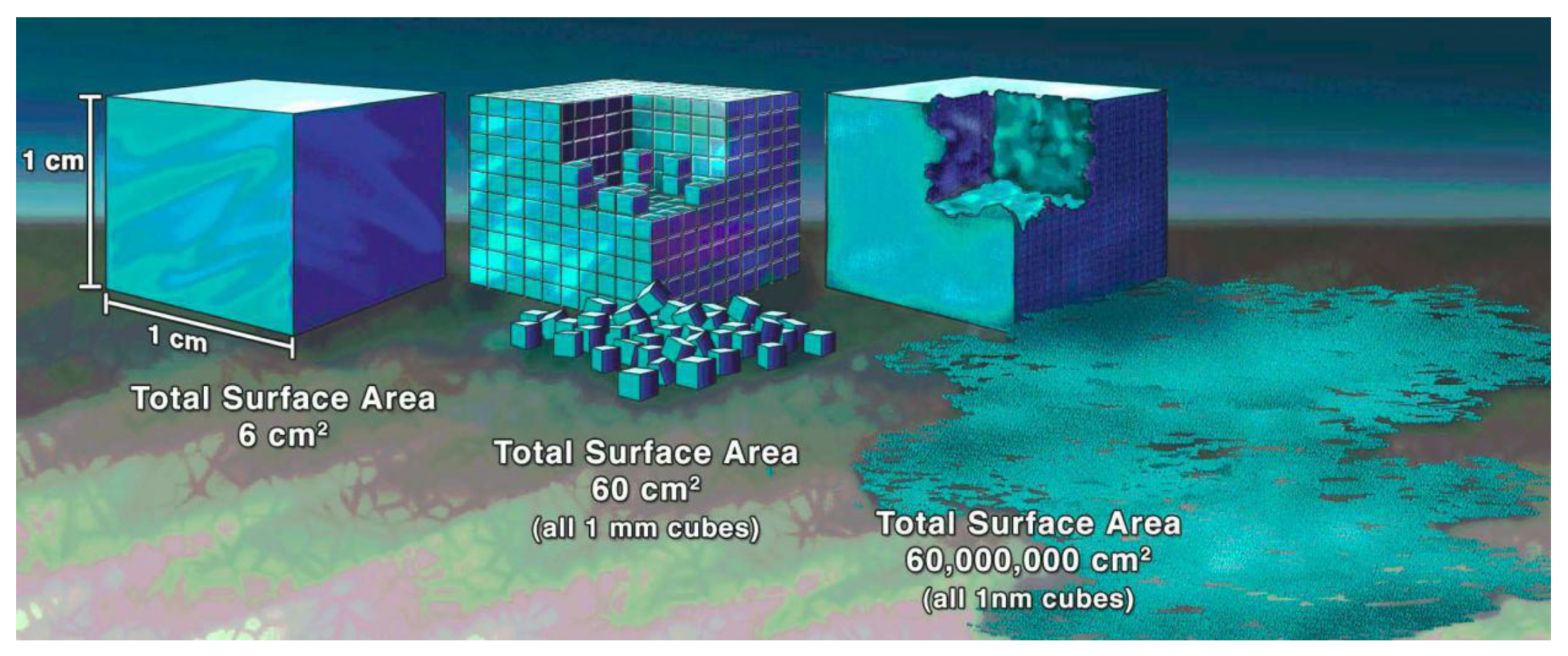

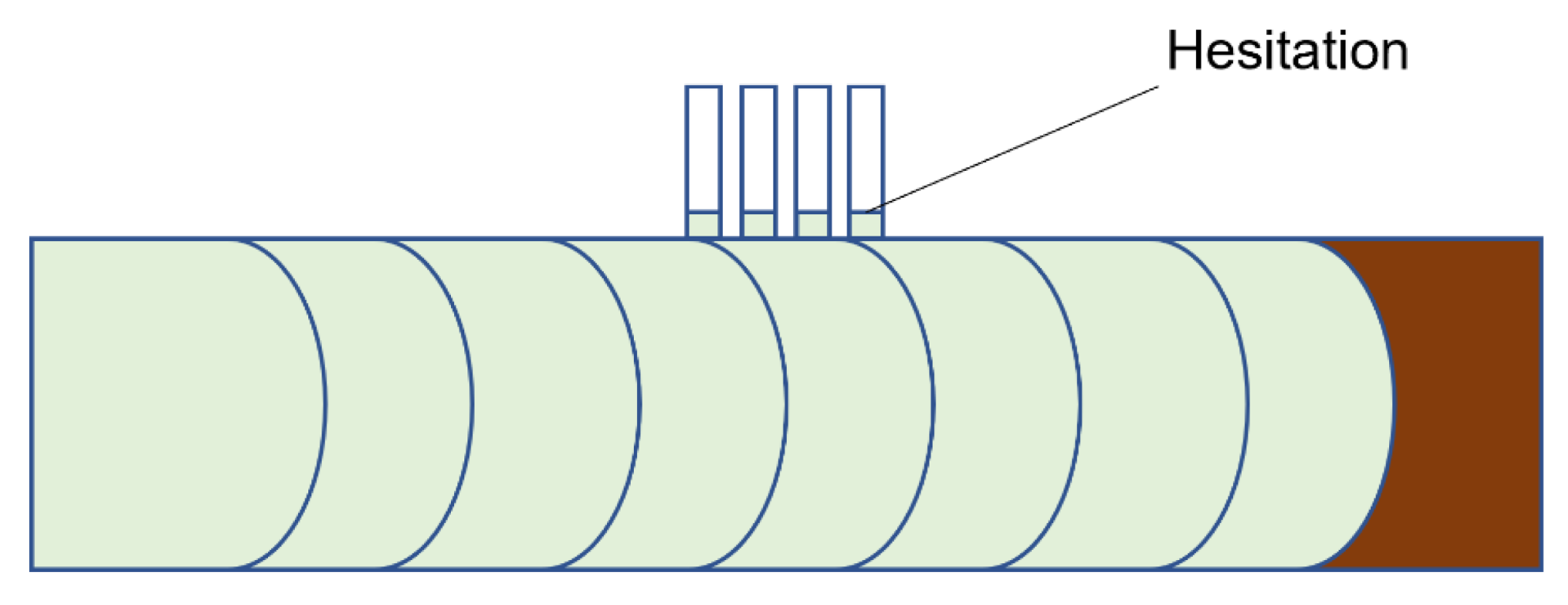
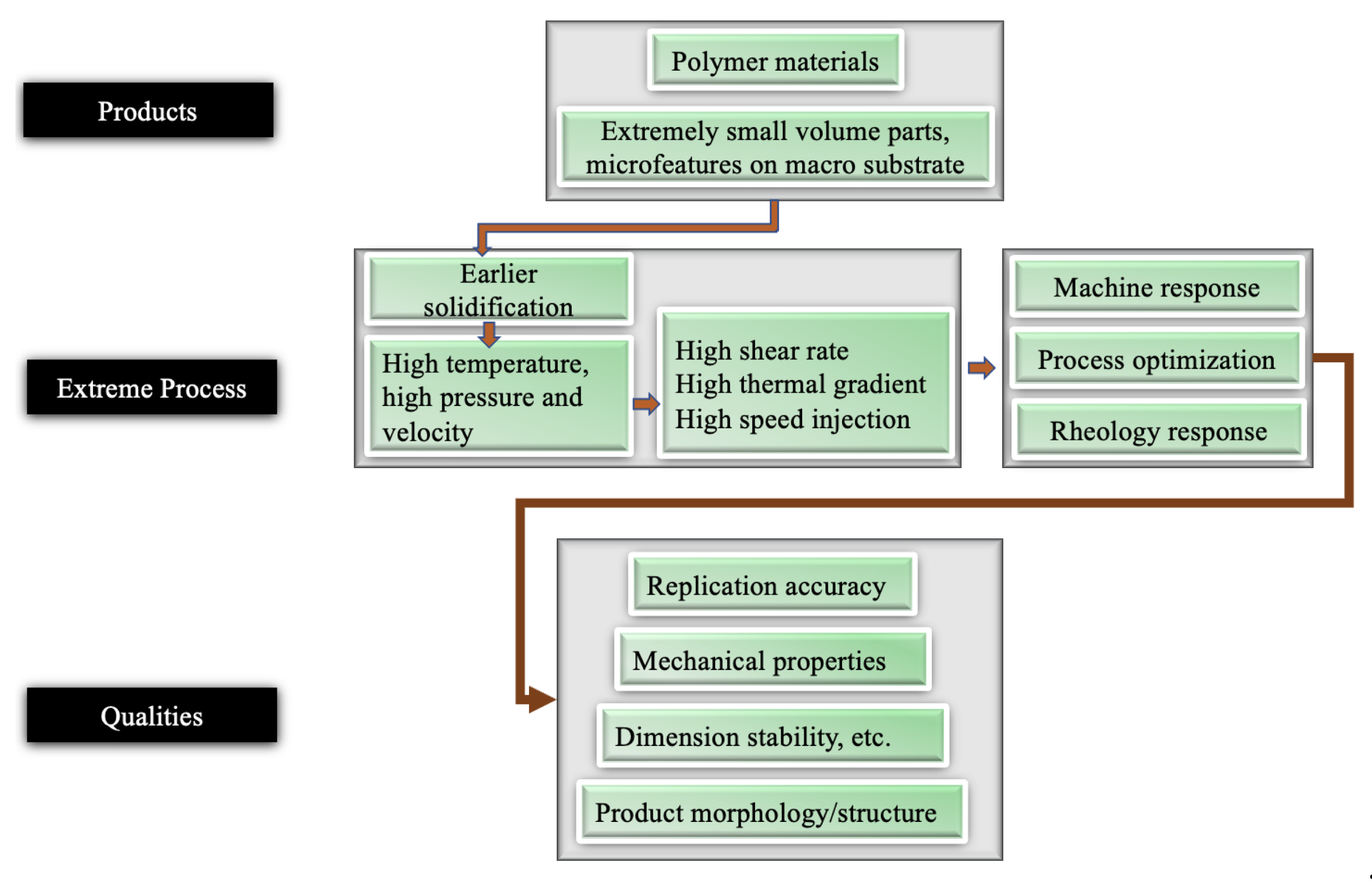
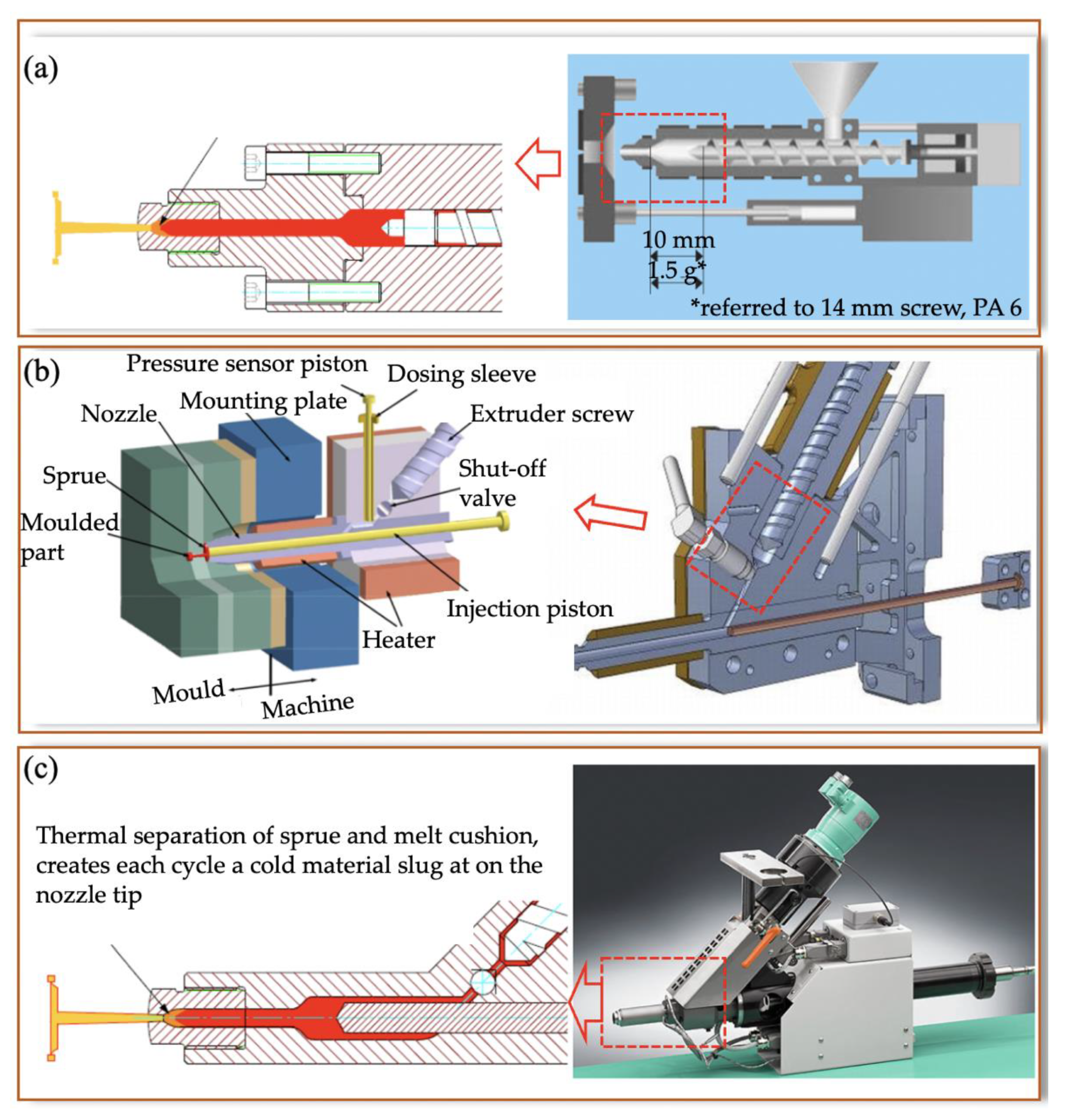
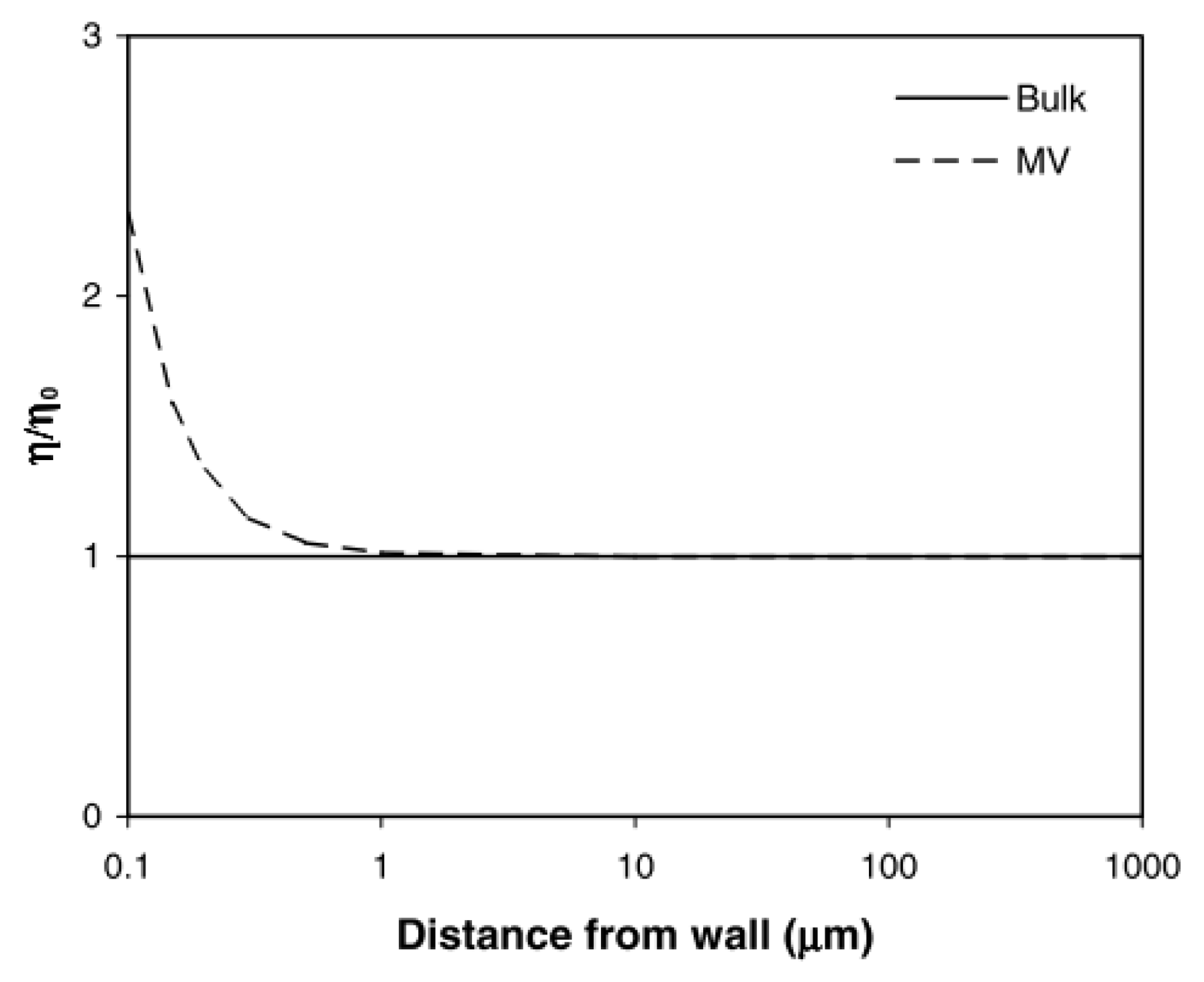
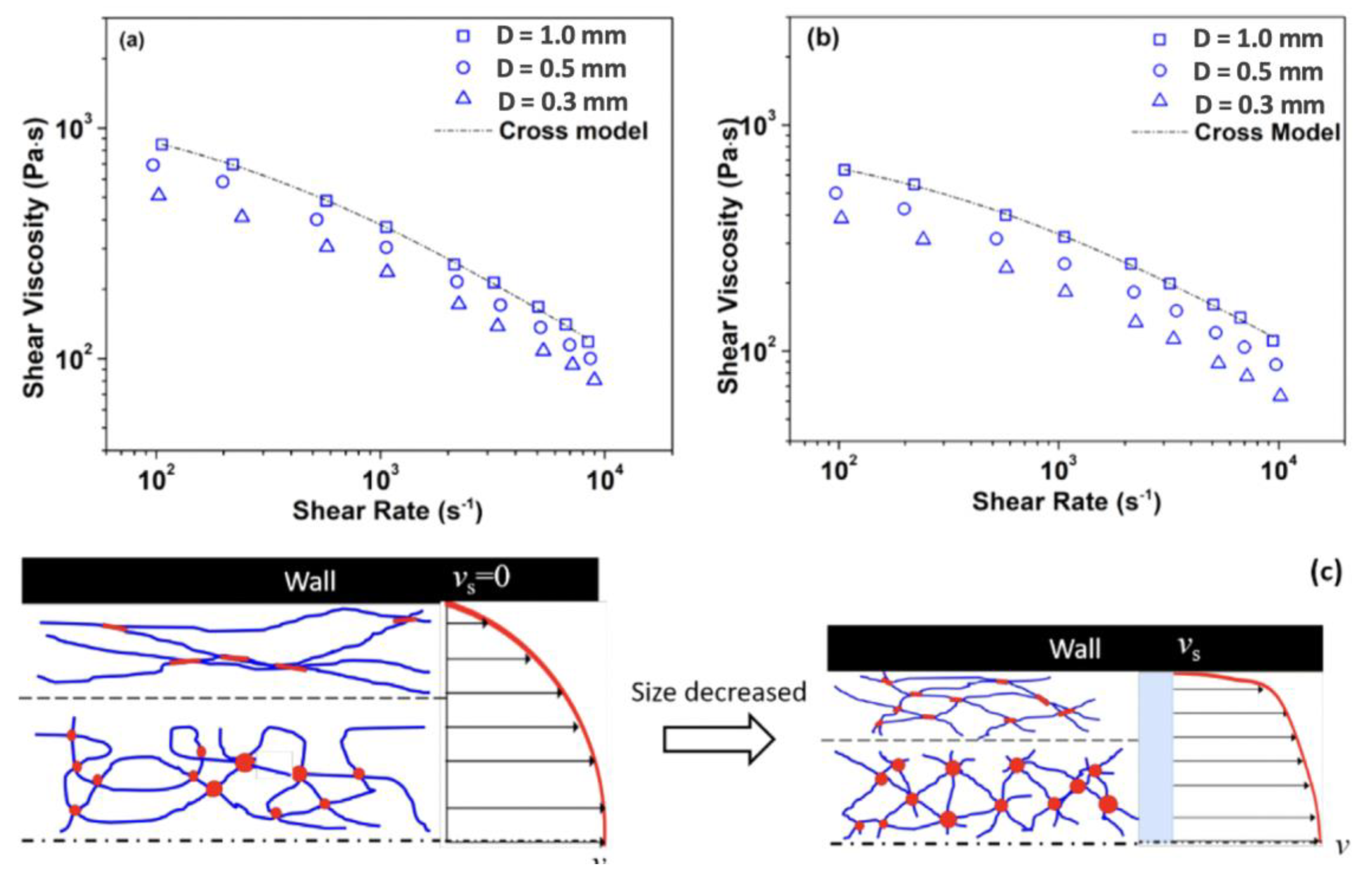

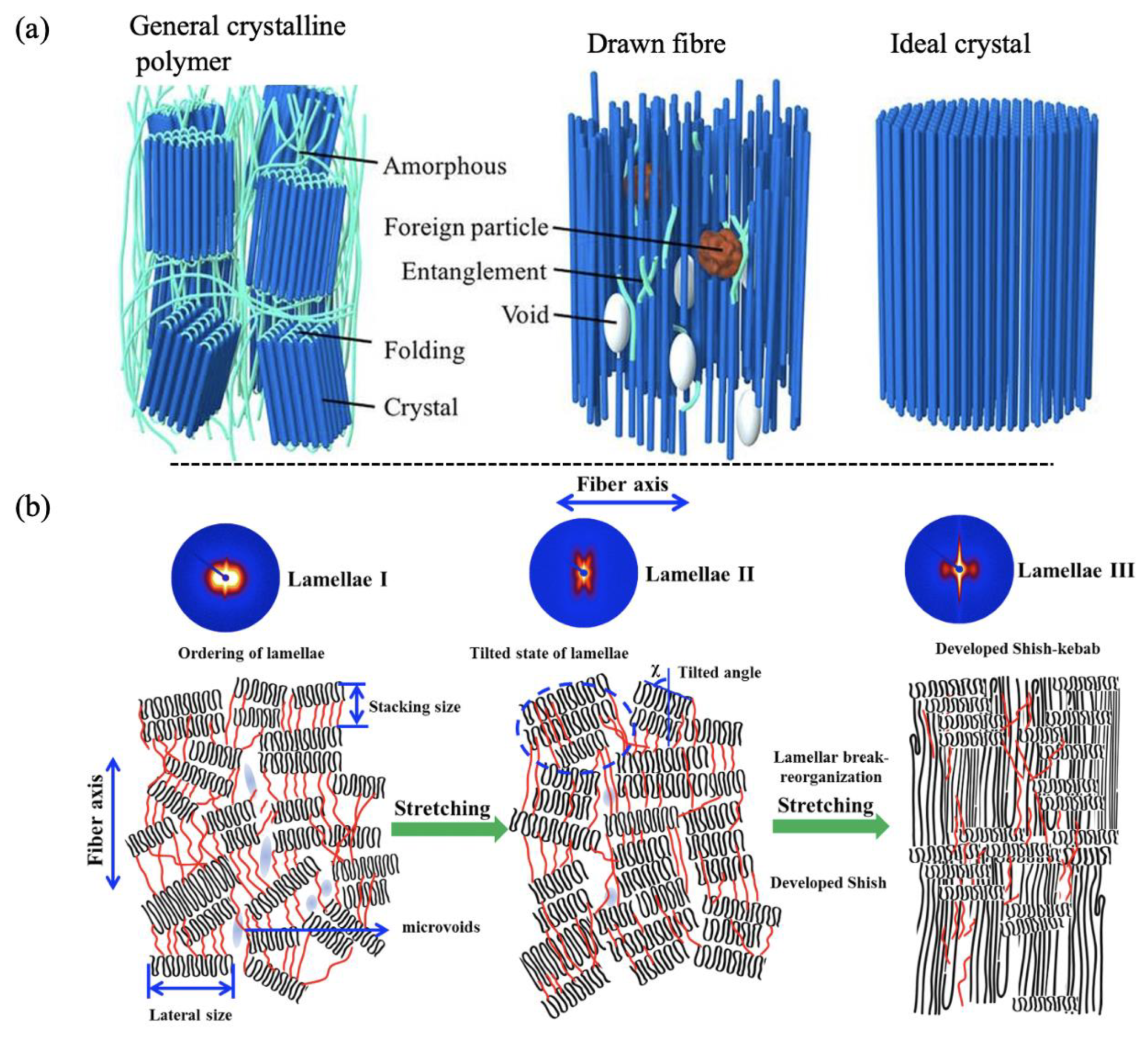

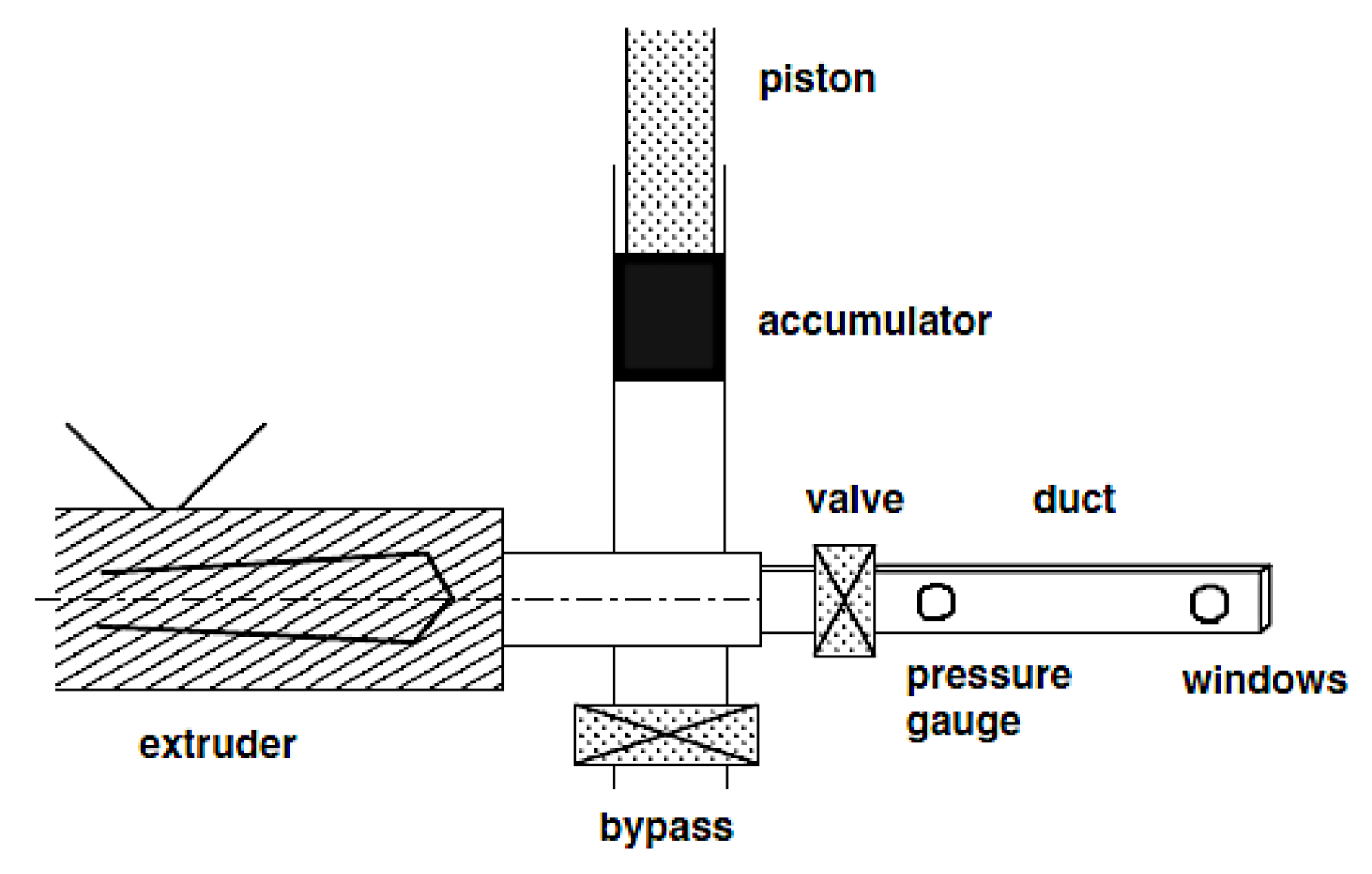

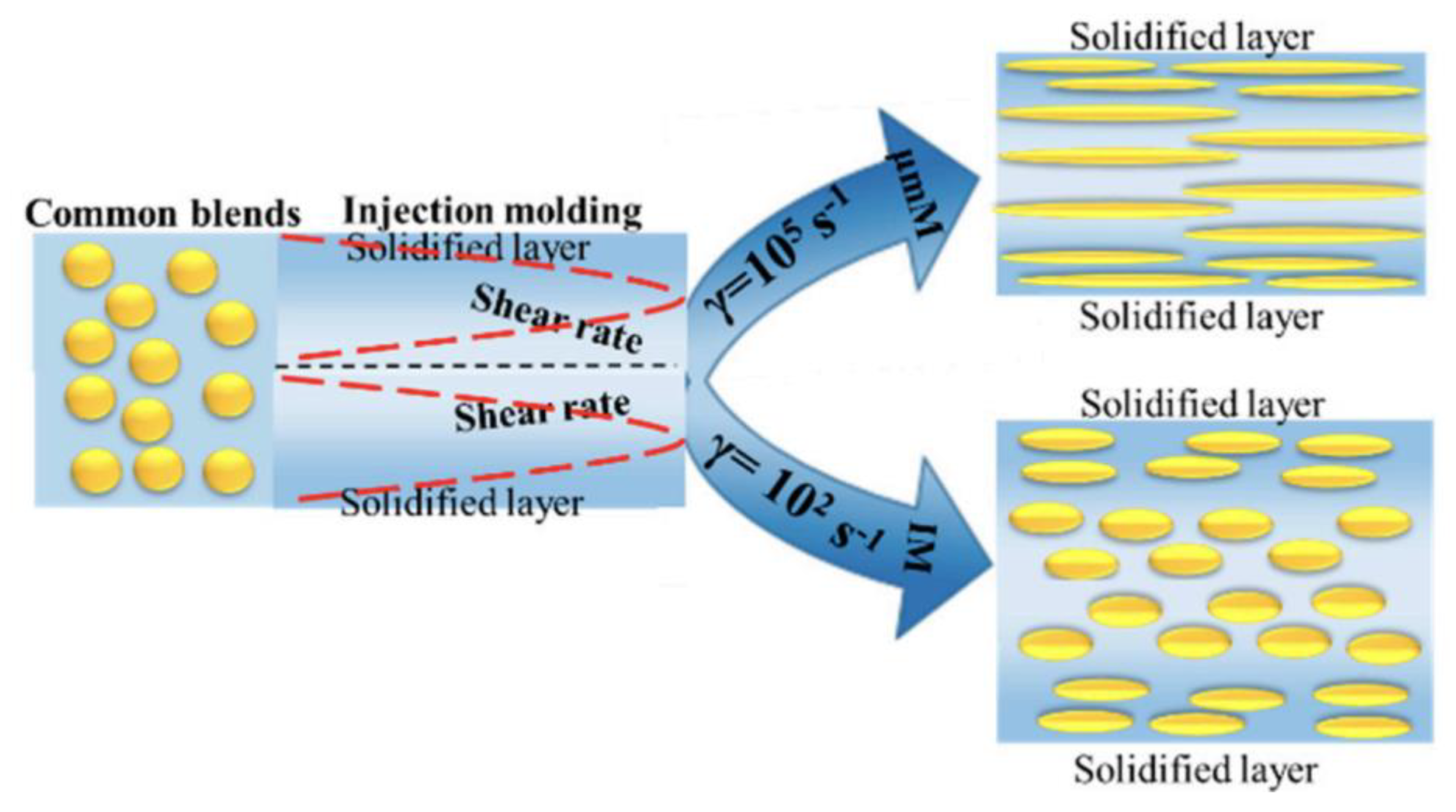
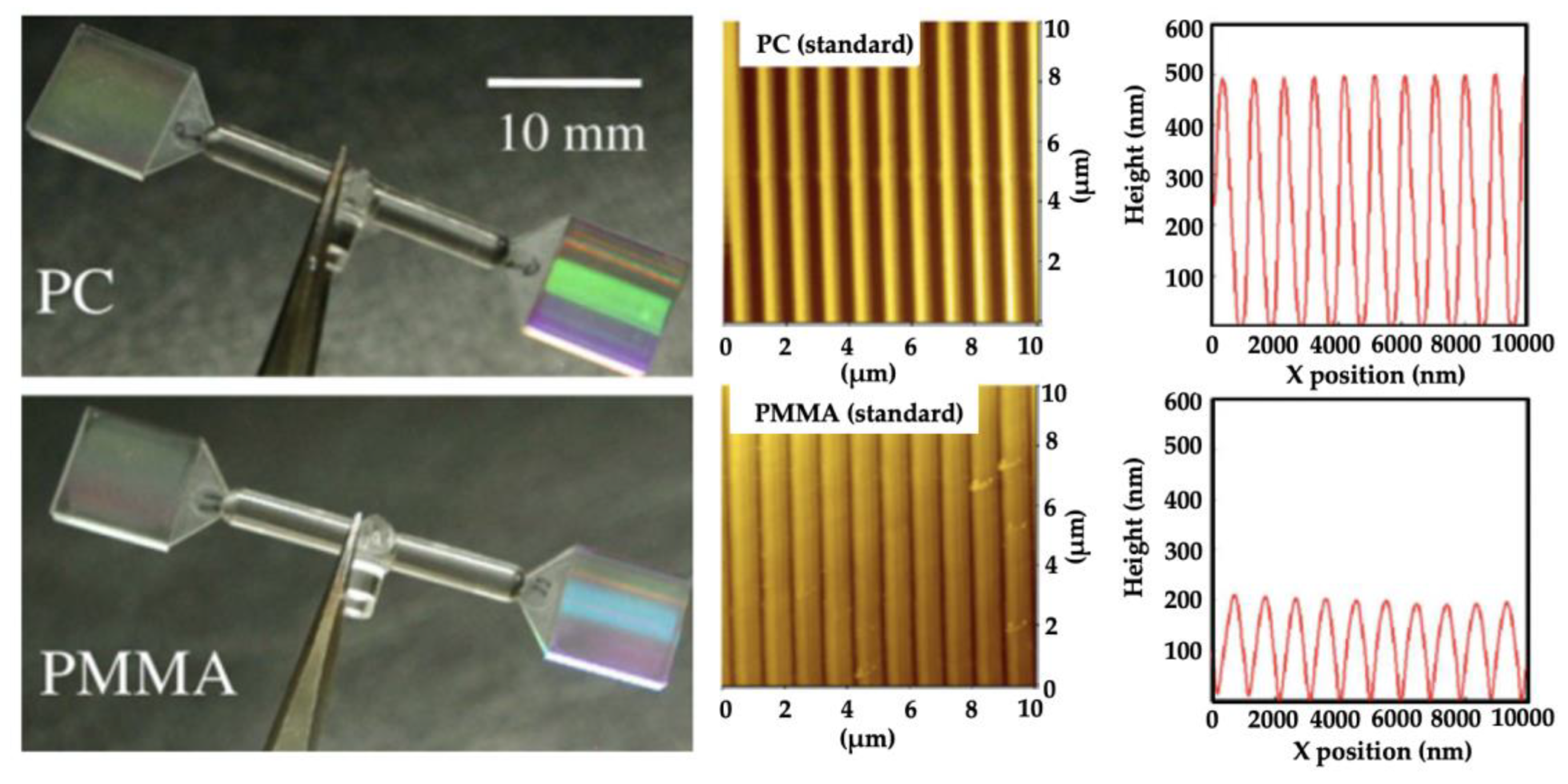
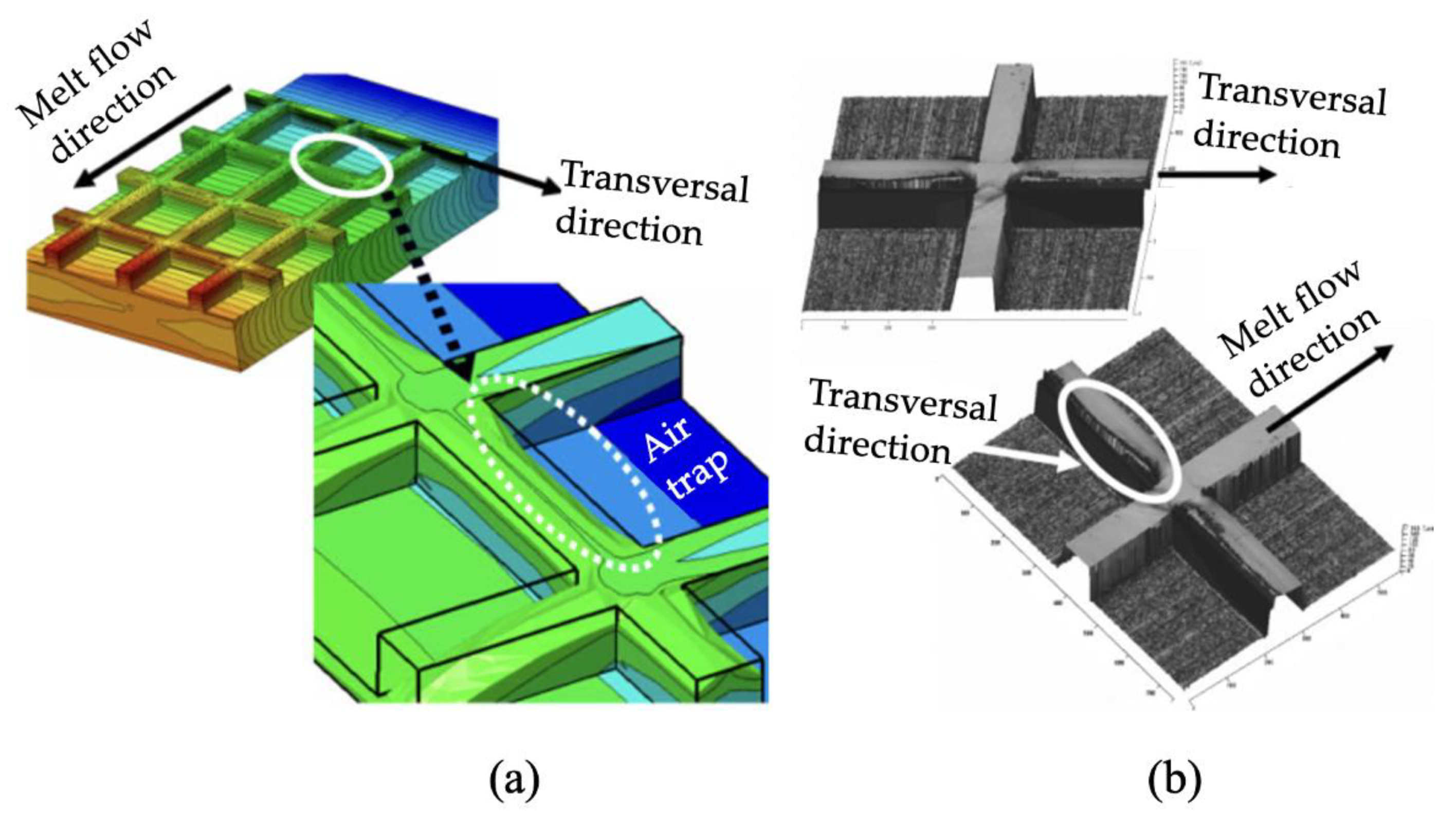
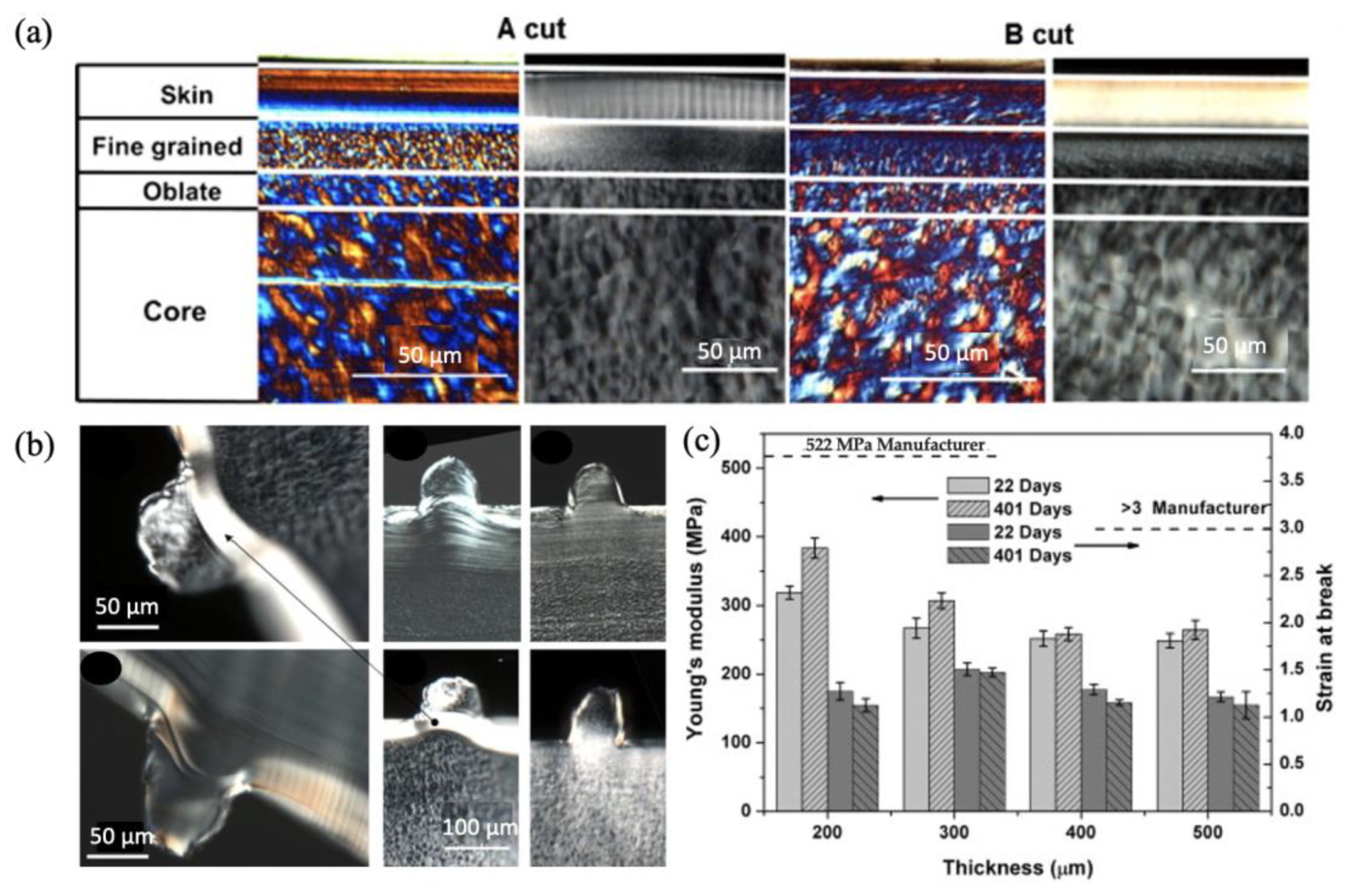

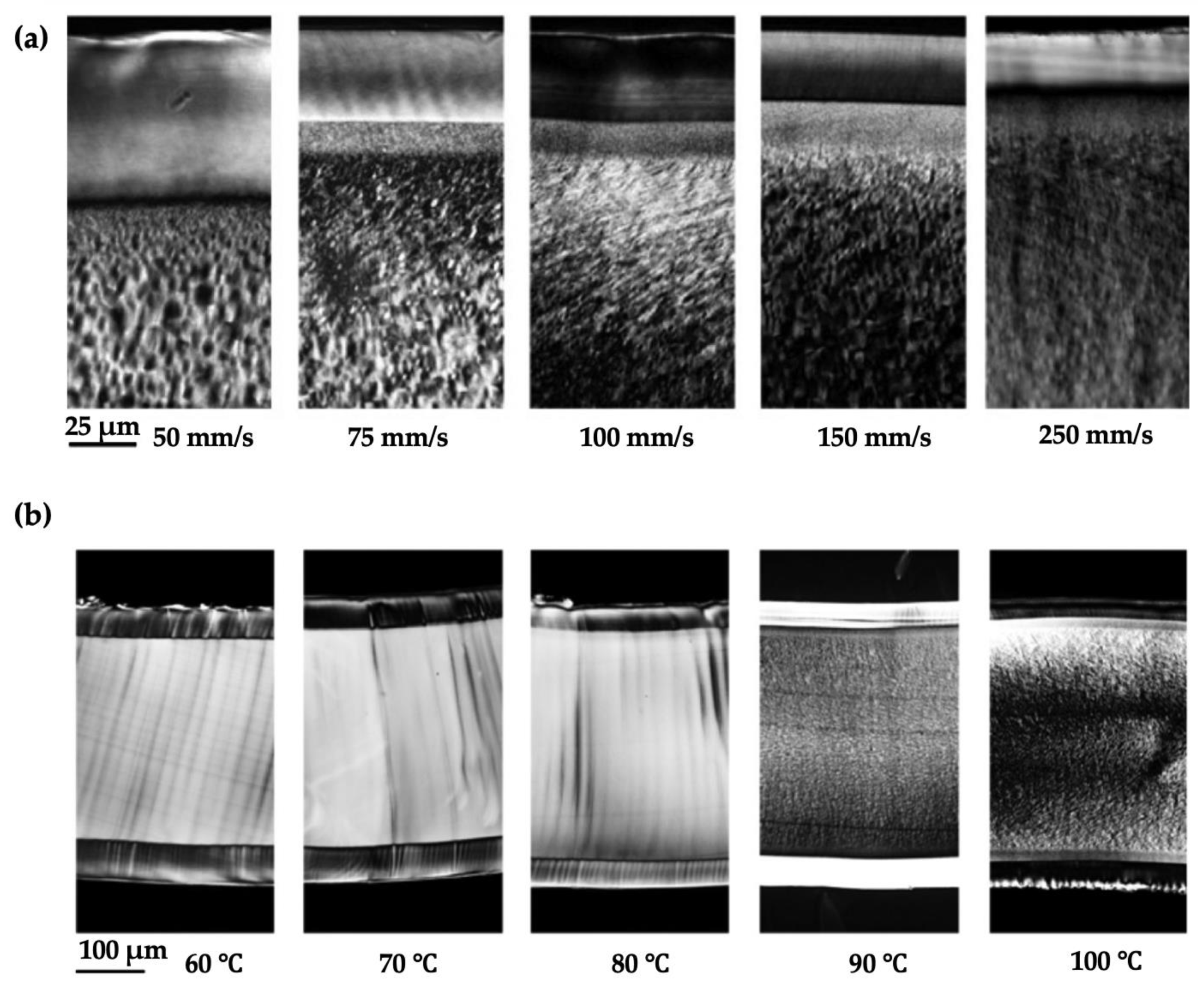
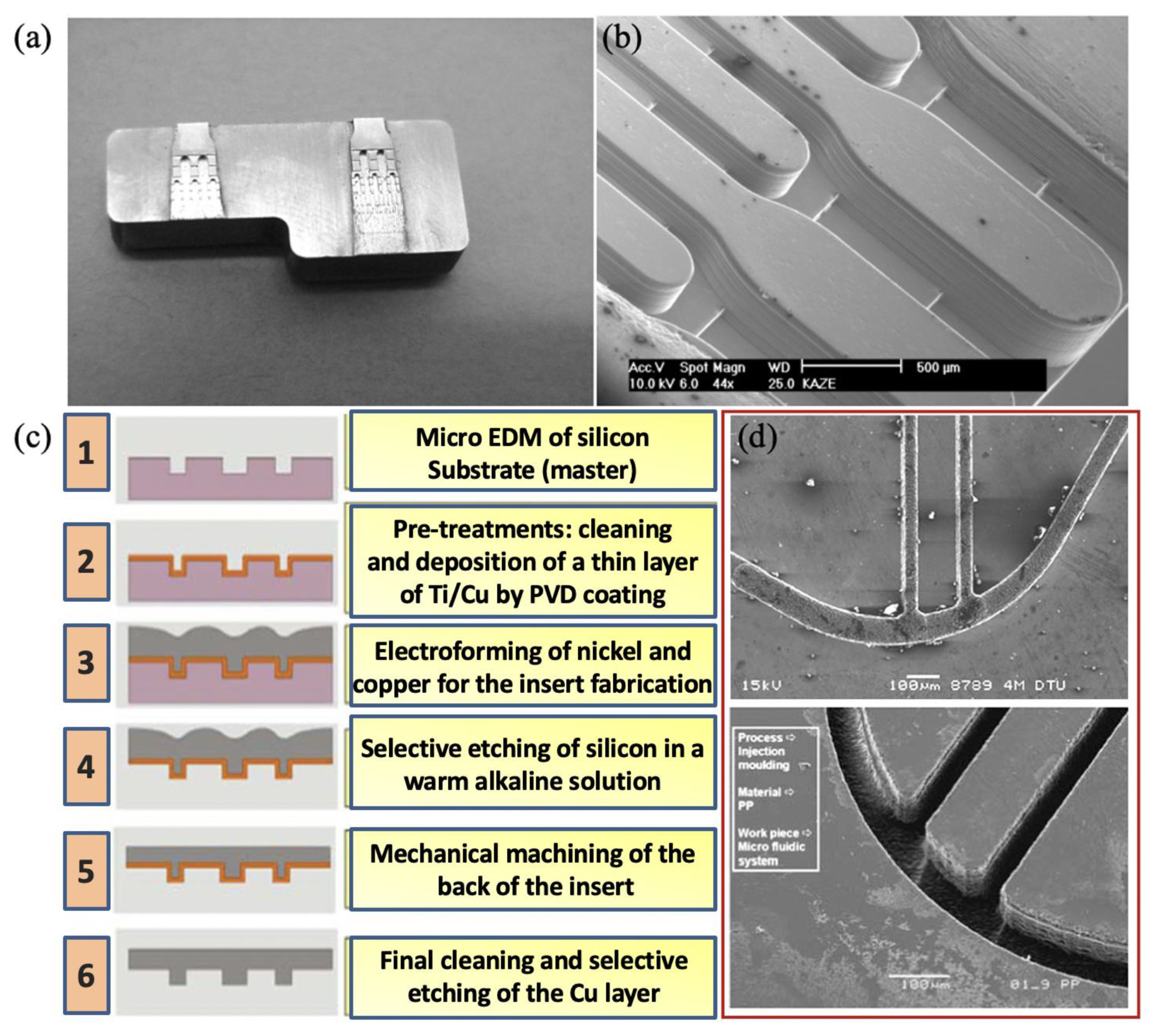
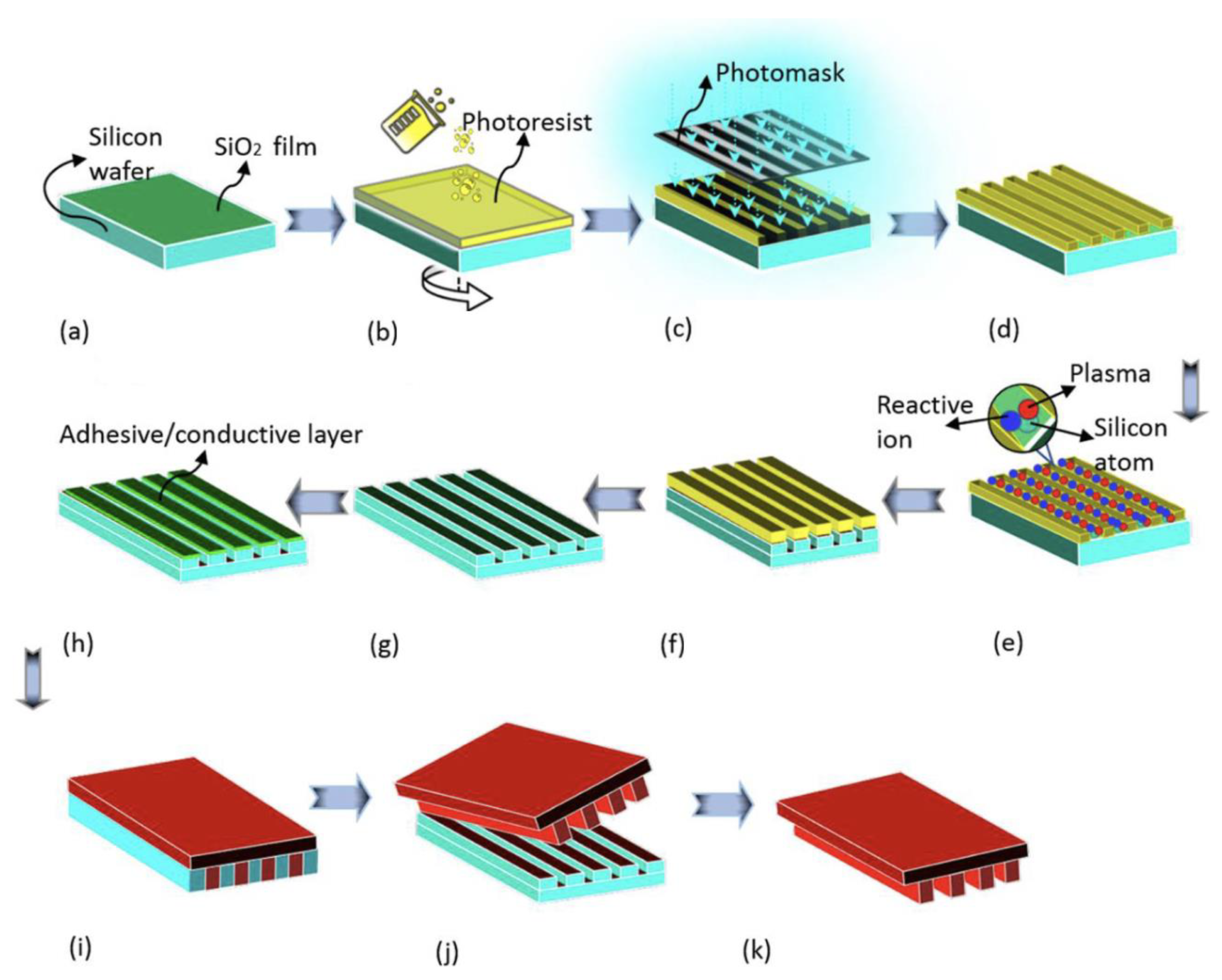
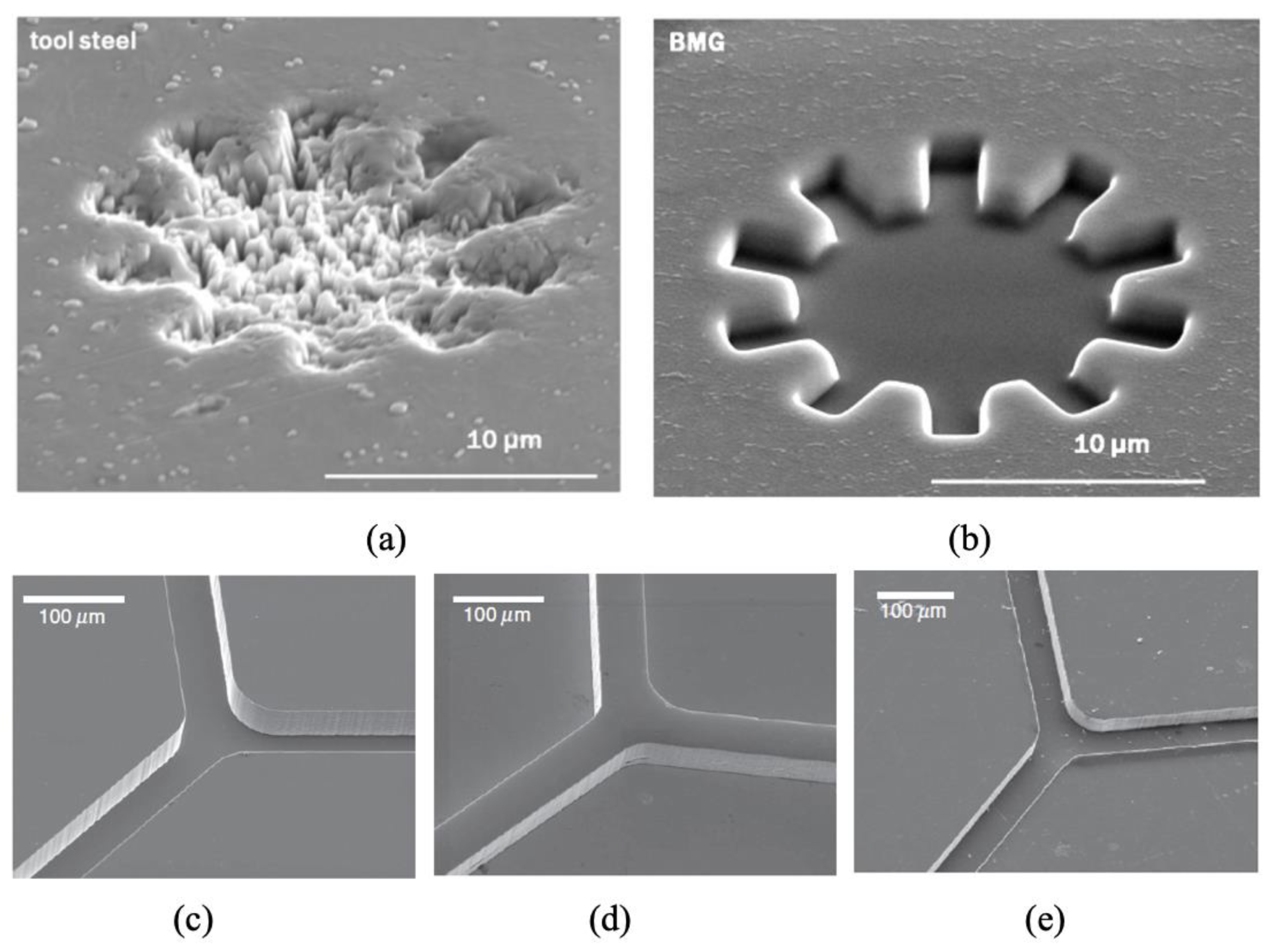



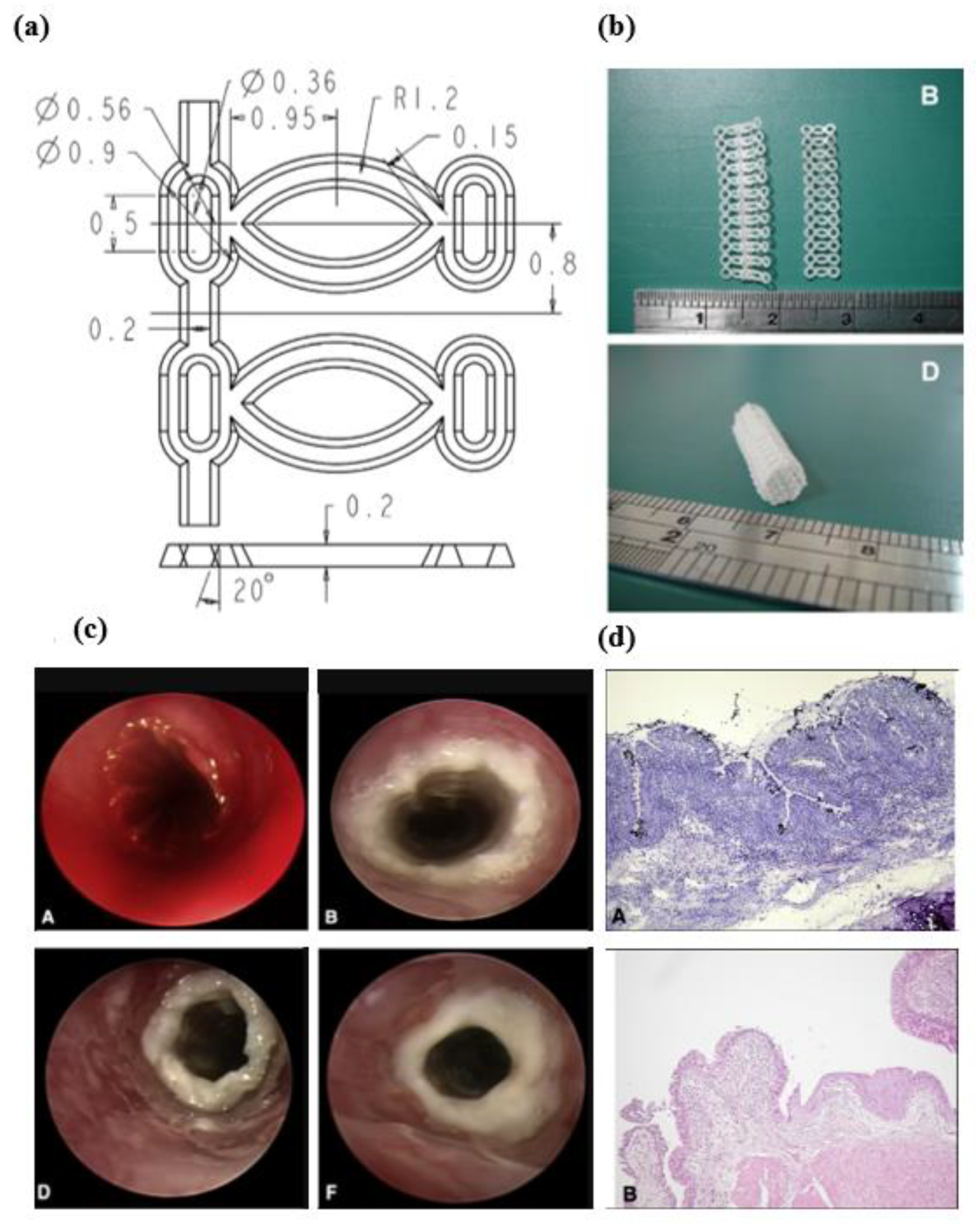

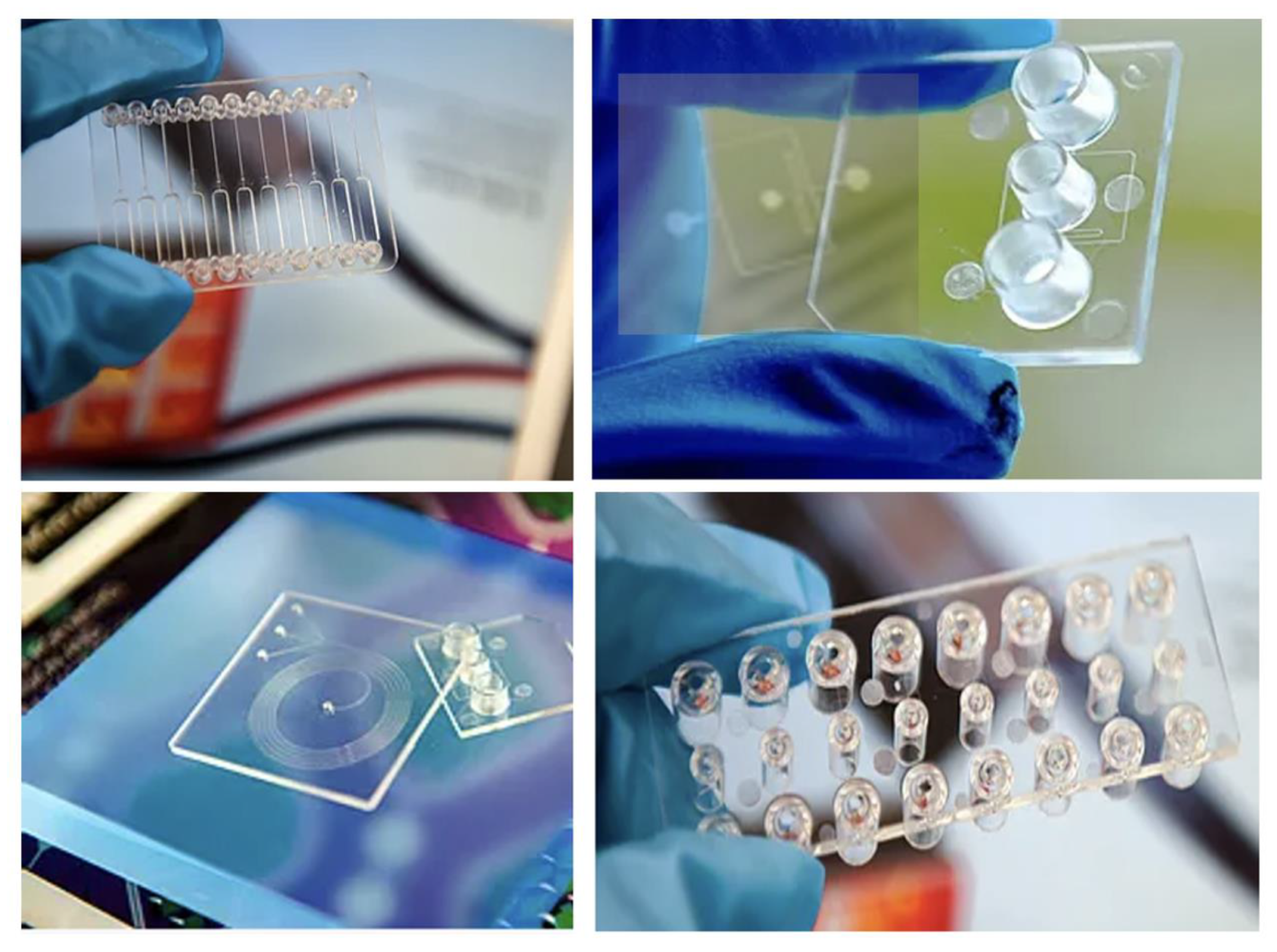
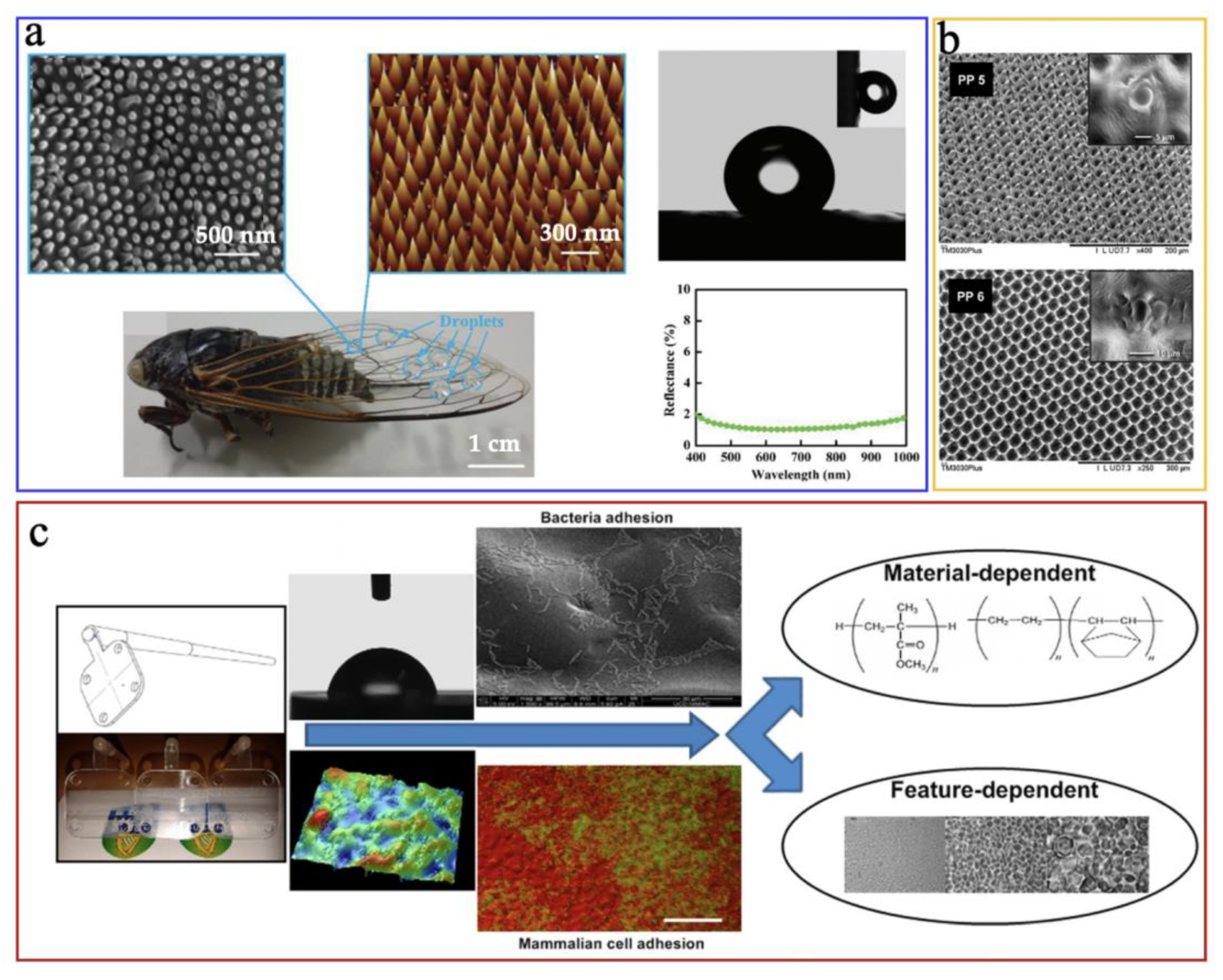

| Manufacturer | Model | Clamp Force (kN) | Injection Capacity (cm3) | Injection Pressure (Bars) | Plasticization (Screw or Plunger) | Injection Speed (mm s−1) |
|---|---|---|---|---|---|---|
| Lawton (Fridingen, Germany) | Sesame Nanomolder | 13.6 | 0.082 | 3500 | 10 mm plunger | 1200 |
| APM (Taichung, Japan) | SM-5EJ | 50 | 1 | 2450 | 14 mm screw | 800 |
| Battenfeld (Barcelona, Spain) | Microsystem 50 | 56 | 1.1 | 2500 | 14 mm screw | 760 |
| Nissei (New Taipei, Japan) | AU3 | 30 | 3.1 | 14 mm screw | ||
| Babyplast (Lyon, France) | Babyplast 6/10 | 62.5 | 4 | 2650 | 10 mm plunger | |
| Sodick (Warwick, UK) | TR05EH | 49 | 4.5 | 1970 | 14 mm screw | 300 |
| Rondol (Nancy, France) | High Force 5 | 50 | 4.5 | 1600 | 20 mm screw | |
| Boy (Exton, PA, United States) | 12/AM | 129 | 4.5 | 2450 | 12 mm screw | |
| Toshiba (Troy, MI, United States) | EC5-01.A | 50 | 6 | 2000 | 14 mm screw | 150 |
| Fanuc (Yamanashi, Japan) | Roboshot S2000-I 5A | 50 | 6 | 2000 | 14 mm screw | 300 |
| Sumimoto (Suwanee, GA, United States) | SE7M | 69 | 6.2 | 1960 | 14 mm screw | 300 |
| Milacron (Batavia, NY, United States) | Si-B 17 A | 147 | 6.2 | 2452 | 14 mm screw | |
| MCP (America North (USA-Canada-Mexico)) | 12/90 HSE | 90 | 7 | 1728 | 16 mm screw | 100 |
| Nissei (New Taipei, Japan) | EP5 Real Mini | 49 | 8 | 1960 | 16 mm screw | 250 |
| Toshiba (Michigan, United States) | NP7 | 69 | 10 | 2270 | 16 mm screw | 180 |
| Technology | Minimum Feature Size (µm) | Surface Roughness (µm) | Aspect Ratio | Material | Manufacturing Cost ($) | Other Applications |
|---|---|---|---|---|---|---|
| Micro milling | 25–100 | 0.2–5 | 10 | Brass, COC, Steel | 500~1000 | Microstructures and micro-texturing in MEMS devices, micro-fuel cells, microfluidic chips, EDM electrodes, and optics, etc. |
| Micro electro discharge machining | 10–25 | 0.05–1 | 50–100 | Conductive material | ~3000 | Inkjet nozzles of printers, cooling holes of turbine blades, and honeycomb structures, etc. |
| Micro laser machining | 1–5 | 0.4–1 | <50 | Any | ~3000 | Photonics, surface plasma resonance, optoelectronics, bio-sensing, micro/nanofluidic, etc. |
| Micro electrochemical machining | 10 | 0.02 | NA | Conductive material | NA | Turbine blades, shaving heads, artillery projectiles, and surgical implants, etc. |
| X-ray lithography | 0.5 | 0.02 | 100 | Photoresist | >10,000 | Diffractive and refractive optics, spectrometer, X-ray grating interferometry, and mask, etc. |
| Ultraviolet lithography | 0.7–1.5 | NA | 22 | Photoresist | 1000 | |
| Deep reactive ion etching | 2 | NA | 10-20 | Silicon | 1000~3000 | MEMS devices, memory circuits, mask, and flexible electronics, etc. |
| Focused ion beam lithography | 0.1 | NA | 3 | Any | 1000~5000 | Semiconductor devices, integrated circuits, bio-sensing, and nano-optics, etc. |
| Electroforming | 0.3 | 0.1 | <10 | Conductive material | 1000~3000 | CDs, DVDs, Blu-ray discs, metal mesh, micro-optics, microfluidics, and microelectronics, etc. |
Publisher’s Note: MDPI stays neutral with regard to jurisdictional claims in published maps and institutional affiliations. |
© 2022 by the authors. Licensee MDPI, Basel, Switzerland. This article is an open access article distributed under the terms and conditions of the Creative Commons Attribution (CC BY) license (https://creativecommons.org/licenses/by/4.0/).
Share and Cite
Zhang, H.; Liu, H.; Zhang, N. A Review of Microinjection Moulding of Polymeric Micro Devices. Micromachines 2022, 13, 1530. https://doi.org/10.3390/mi13091530
Zhang H, Liu H, Zhang N. A Review of Microinjection Moulding of Polymeric Micro Devices. Micromachines. 2022; 13(9):1530. https://doi.org/10.3390/mi13091530
Chicago/Turabian StyleZhang, Honggang, Haibin Liu, and Nan Zhang. 2022. "A Review of Microinjection Moulding of Polymeric Micro Devices" Micromachines 13, no. 9: 1530. https://doi.org/10.3390/mi13091530







